Intel Core i3 vs. Core i5 vs. Core i7 vs. Core i9
Practice you need to buy a Cadre i9 for gaming, and is a Core i3 sufficient for general desktop work? How about upgrading to a Core i5 if information technology'southward just $l more, and how much faster is that going to be? Mostly speaking, our CPU reviews provide more plenty data to answer those questions and and so some. In addition, TechSpot's piece of cake to follow Best CPUs guide is regularly updated, so you but get what you lot demand to know to make an informed buying decision.
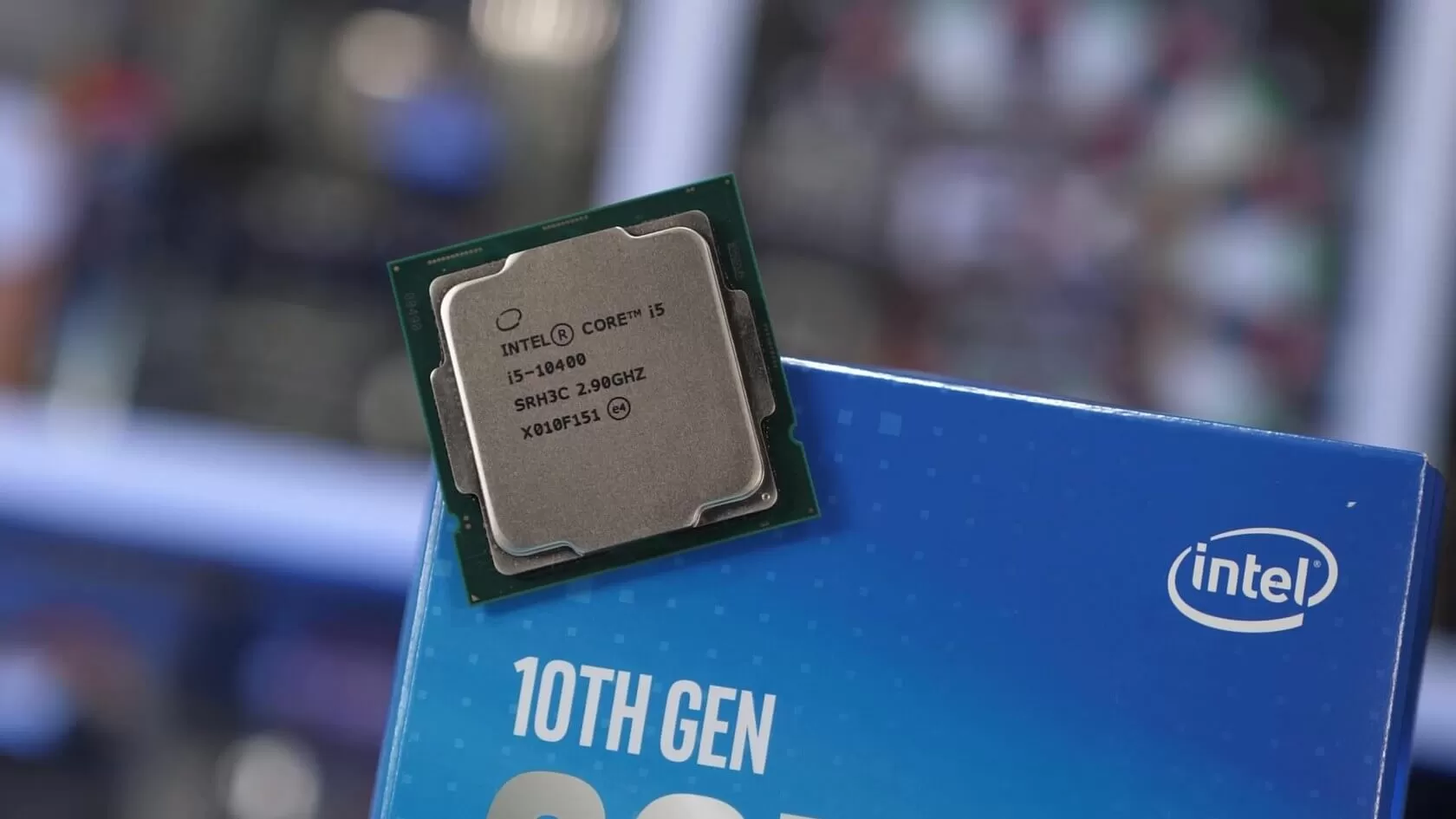
With that said, this review will serve as a great reference for those wanting to compare Intel Core i3, i5, i7 and i9 processors straight, and what you lot get on each jump. It's rare for us to feature all these processors in a unmarried review since they aim at different market segments and budgets. For example, when reviewing the Core i3-10100, none of the Core i7 or i9 processors were included, as $400+ parts aren't usually relevant when reviewing an entry-level $100 CPU, so we opt to remove them in an endeavor to declutter the graphs.
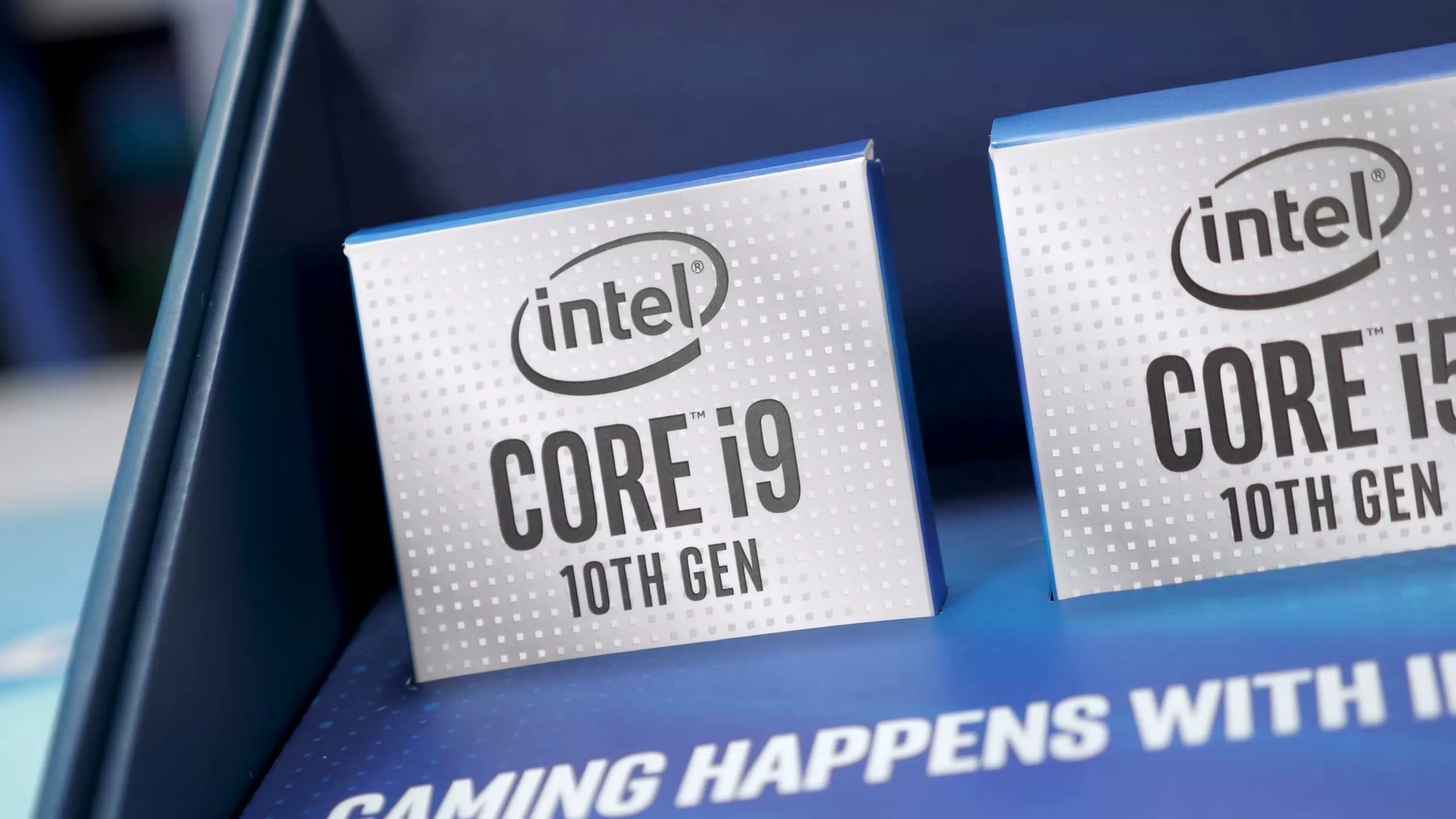
Having recently provided a similar overview for AMD's 3rd-gen Ryzen range, information technology was only logical nosotros did the aforementioned for Intel, because the 10th-gen CPUs have only been out for a few months.
Intel Cadre Lineup Overview
Intel lists 17 individual 'standard power' 10th-gen Cadre desktop processors, though in reality in that location'due south just a handful of unique models. For example, there are two singled-out Cadre i9 models, the 10900 and the 10900K, but each has an alternate version without the integrated graphics -- dubbed the 10900F and 10900KF. But permit'due south start from the bottom and work our way up...
The 10th-gen Cadre i3 range is quite interesting, all models feature 4 cores and 8 threads thanks to Hyper-Threading support. The base i3-10100 model operates at a base frequency of 3.vi GHz with a max turbo of 4.3 GHz and packs a 6 MB L3 cache. And then there's the Core i3-10300 which gets a 100 MHz frequency crash-land plus a larger viii MB L3 cache. Finally, the virtually powerful Core i3 model bachelor correct now is the 10320, which runs at even college clock speeds, boosting the base to 3.8 GHz and the max turbo to iv.half-dozen GHz. To represent the Cadre i3 range today nosotros'll exist using the Core i3-10100.
| Core i3-10100 | Cadre i3-10300 | Cadre i3-10320 | |
|---|---|---|---|
| List Price | $122 | $143 | $154 |
| Current Retail | $130 | $158 | $172 |
| Cores / Threads | 4 /8 | ||
| Base Frequency | 3.half dozen GHz | 3.7 GHz | iii.8 GHz |
| Max Turbo | 4.three GHz | 4.4 GHz | iv.6 GHz |
| L3 Cache | 6 MB | eight MB | |
| iGPU Model | UHD Graphics 630 | ||
| TDP | 65 watt | ||
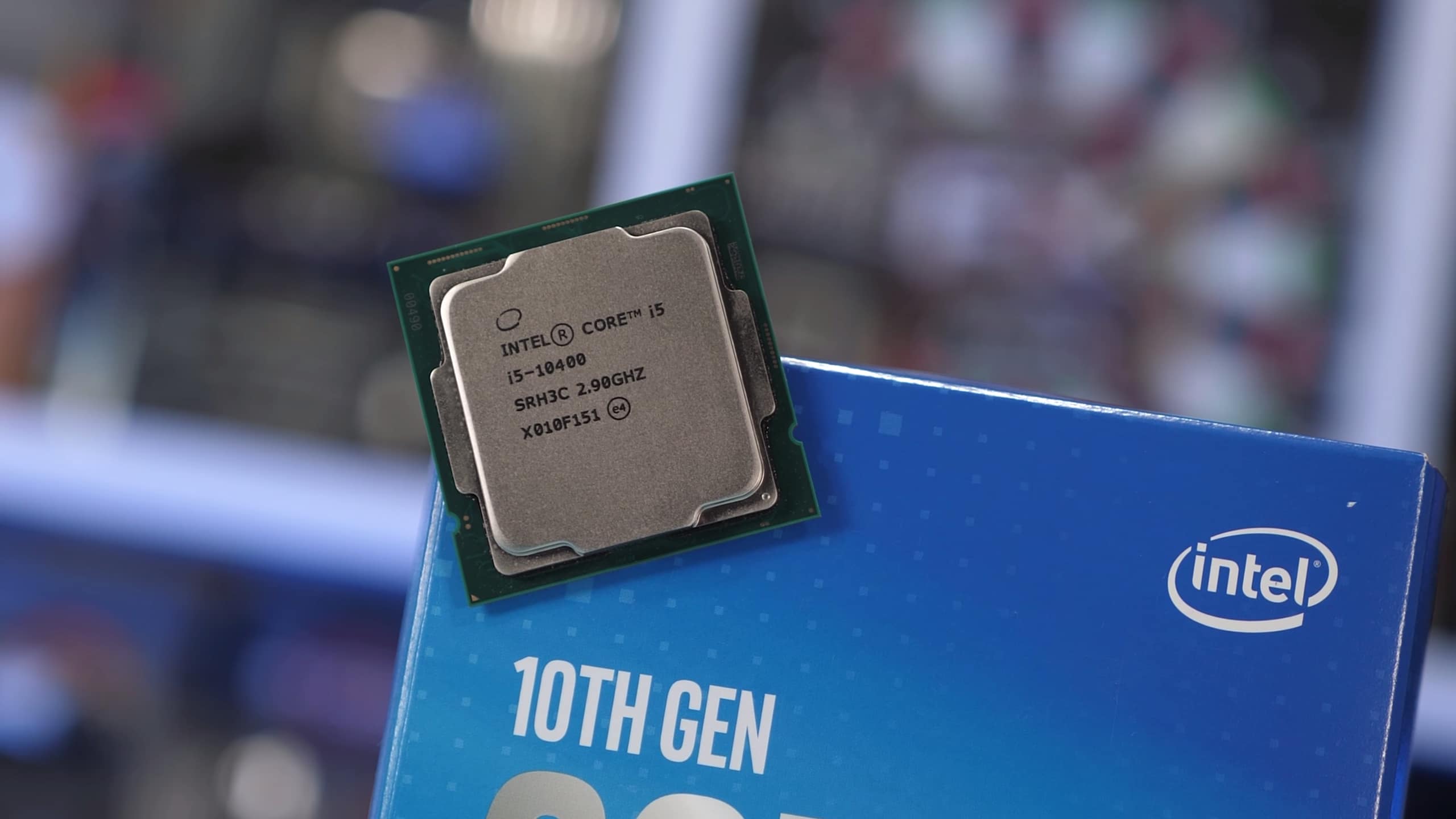
The 10th-gen Core i5 series consists of the 10400, 10400F, 10500, 10600, 10600K and the 10600KF every bit shown in the table below. The six models feature 6 cores, 12 threads and a 12MB L3 cache. The non-K models are rated with a 65-watt TDP while the unlocked G SKUs pack a 125-watt TDP.
The difference betwixt the 10400, 10500 and 10600 is 200 to 300 MHz, that'due south information technology, and since they're locked parts you won't be able to modify that. The 10600K and its F variant are fully unlocked, provided you're using a Z-series motherboard, they can be overclocked.
| Core i5 10400 | Core i5 10400F | Core i5 10500 | Core i5 10600 | Core i5 10600K | Core i5 10600KF | |
|---|---|---|---|---|---|---|
| List Price | $182 | $157 | $192 | $213 | $262 | $237 |
| Current Retail | $182 | $170 | $233 | $288 | $306 | N/A |
| Cores / Threads | six / 12 | |||||
| Base Frequency | ii.9 GHz | three.1 GHz | 3.3 GHz | 4.1 GHz | ||
| Max Turbo | 4.3 GHz | 4.five GHz | 4.8 GHz | |||
| L3 Enshroud | 12 MB | |||||
| iGPU | UHD Graphics 630 | N/A | UHD Graphics 630 | UHD Graphics 630 | UHD Graphics 630 | North/A |
| TDP | 65 watt | 125 watt | ||||
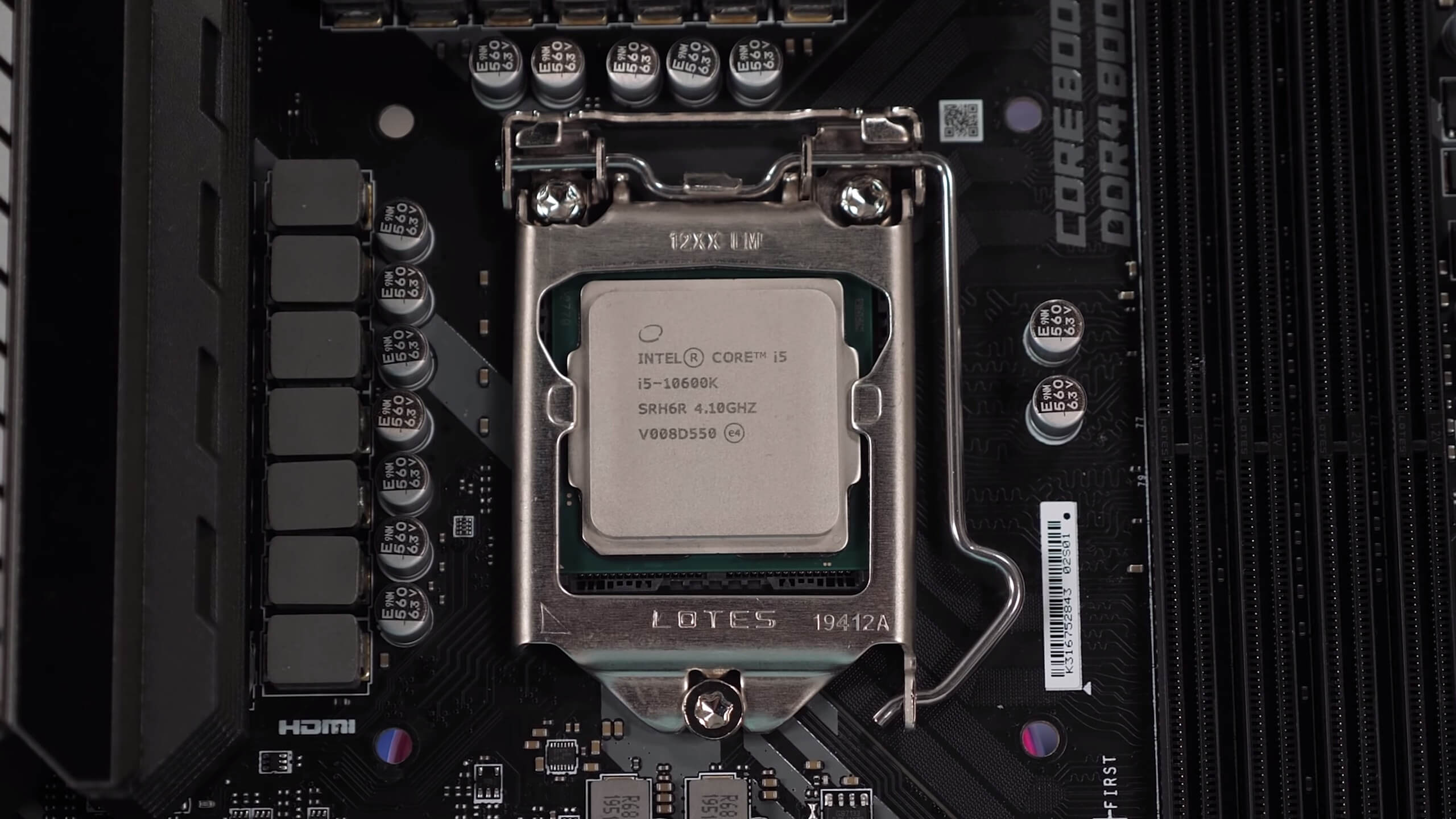
The Core i7 range is somewhat simplified, there are ii distinct eight-core/16-thread models. The Core i7-10700 is the locked part, it runs at a 2.9 GHz base clock with a max turbo of four.eight GHz, whereas the 10700K is unlocked and out of the box runs at 3.eight GHz for the base and v.ane GHz for the heave. The locked model receives a 65-watt TDP rating and the unlocked role a 125-watt TDP. Both feature a 16 MB L3 enshroud.
| Core i7-10700 | Core i7-10700F | Cadre i7-10700K | Core i7-10700KF | |
|---|---|---|---|---|
| List Price | $323 | $298 | $374 | $349 |
| Current Retail | $329 | Due north/A | $410 | Northward/A |
| Cores / Threads | 8 / xvi | |||
| Base Frequency | ii.9 GHz | 3.8 GHz | ||
| Max Turbo | 4.eight GHz | v.1 GHz | ||
| L3 Enshroud | 16 MB | |||
| iGPU | UHD Graphics 630 | N/A | UHD Graphics 630 | Northward/A |
| TDP | 65 watt | 125 watt | ||
Finally, we have the mighty Core i9 range offering x cores/20 threads and a 20 MB L3 cache. In that location are 4 models, two of which are F variants. The 10900 is the base model and as a 65-watt part it features a rather low 2.8 GHz base frequency with a 5.1 GHz turbo. And so there'due south the unlocked 10900K that thanks to a college 125 watt TDP rating, it clocks no lower than three.7 GHz with a max turbo boost of v.2 GHz.
| Core i9-10900 | Core i9-10900F | Core i9-10900K | Core i9-10900KF | |
|---|---|---|---|---|
| List Toll | $439 | $422 | $488 | $472 |
| Current Retail | $480 | Due north/A | $530 | N/A |
| Cores / Threads | 10 / twenty | |||
| Base Frequency | 2.eight GHz | 3.seven GHz | ||
| Max Turbo | v.1 GHz | v.2 GHz | ||
| L3 Cache | 20 MB | |||
| iGPU | UHD Graphics 630 | N/A | UHD Graphics 630 | N/A |
| TDP | 65 watt | 125 watt | ||
Unfortunately, right at present many of these 10th-gen Cadre processors are either out of stock or are selling well over the MSRP. It'due south a crude time for supply and on height of that Intel's been suffering 14nm shortages for what seems like years now. Then getting your easily on the Cadre i9-10900K correct at present is nearly impossible and good luck getting one for anywhere near $500.
For this overview, we'll mostly be focusing on the 125 watt parts in the Cadre i5, Cadre i7 and Core i9 range, though we've also been able to secure the 65 watt Core i5-10400 and Core i3-10100.
For testing we're using our standard memory configuration, fully populating an Asus ROG Maximus XII Extreme wit 4 8GB K.Skill FlareX CL14 modules for a 32GB capacity. Every bit usual nosotros're also relying on an RTX 2080 Ti to alleviate potential GPU bottlenecks, allowing us to take a meliorate look at the actual CPU performance.
Benchmarks
Starting with Cinebench R20 nosotros observe that the 10400 is simply shy of 50% faster than the 10100, which makes sense given the i5 processor packs 50% more than cores and clock speeds are nigh the same. Then nosotros see a xiii% jump from the 10400 to the 10600K and this deviation is a result of the operating clock speed, and of course, given that the K SKU part is unlocked, that margin tin can be increased farther past overclocking.
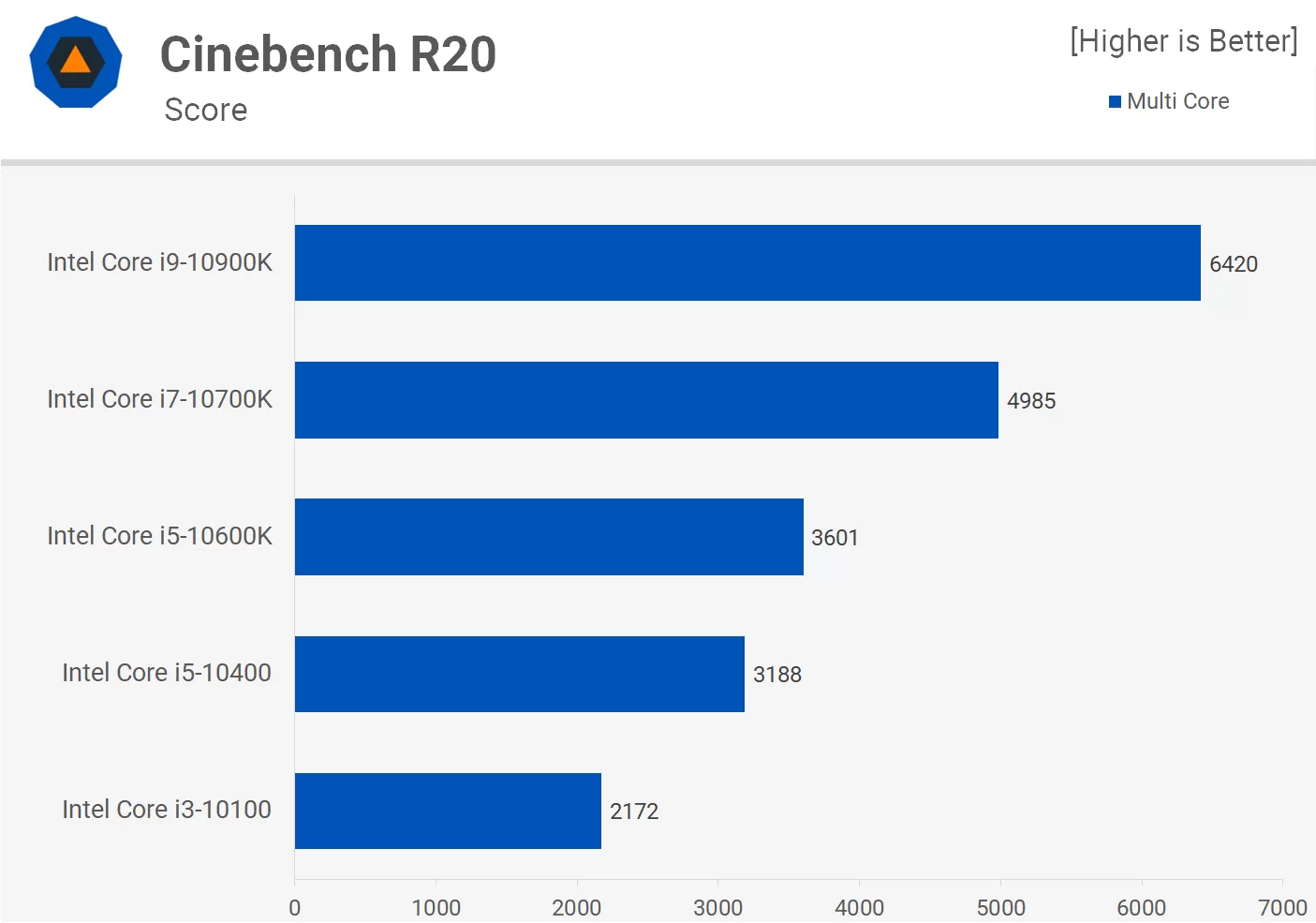
And so we see an about 40% increase when going from the 10600K to the 10700K and of course that's largely due to a 33% increase in cadre count, with the remainder clock speed related as the i7 processor clocks around vi% higher. Finally we see some other big spring in functioning with the 10900K, though this time only a ~29% increment equally the core count has only been boosted by 25% and clock speeds are much the aforementioned.
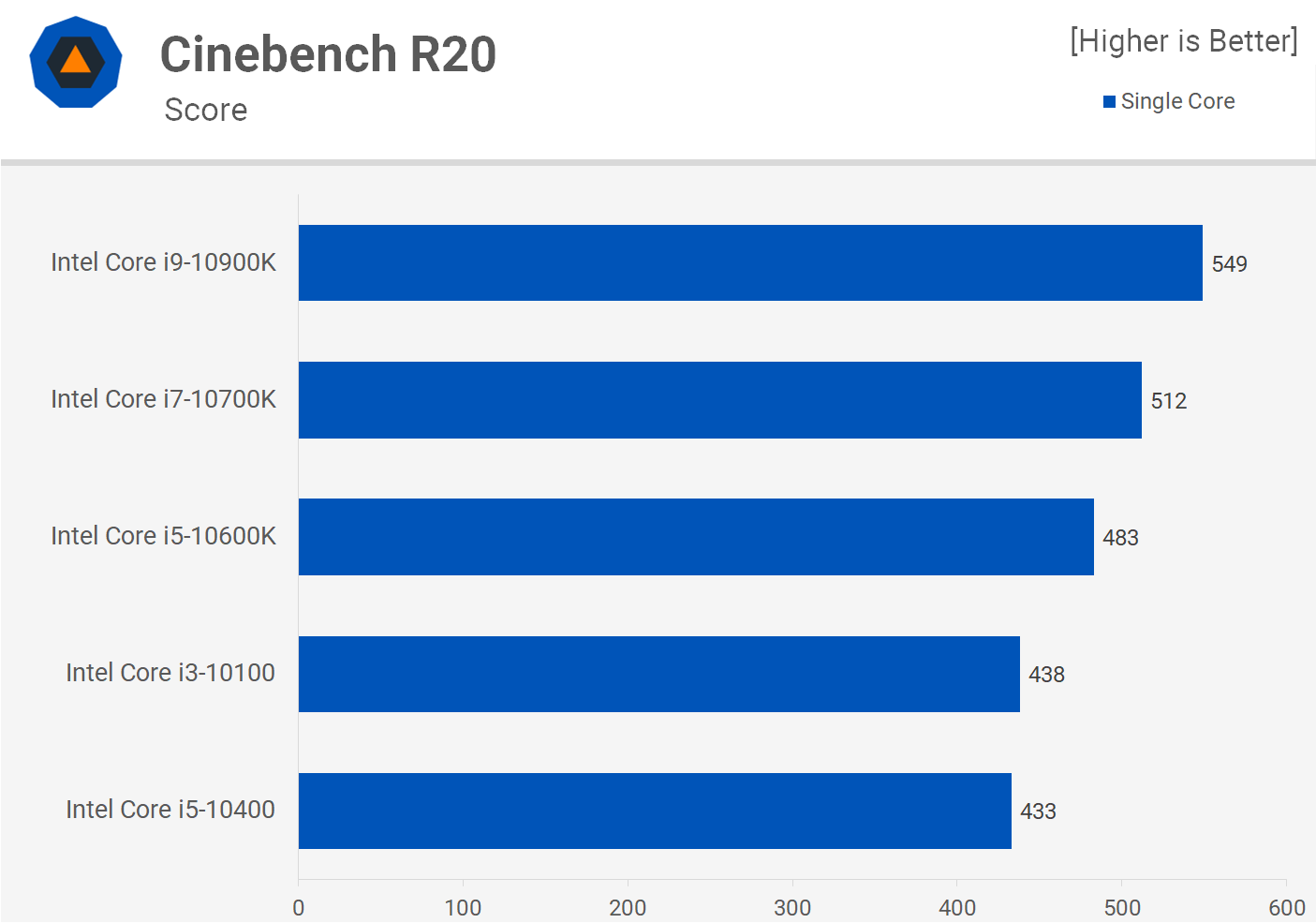
Equally for single cadre performance the 10900K produced the highest score here, chirapsia the 10700K by a 7% margin and the 10600K by a 14% margin while the 10100 and 10400 were comparable.
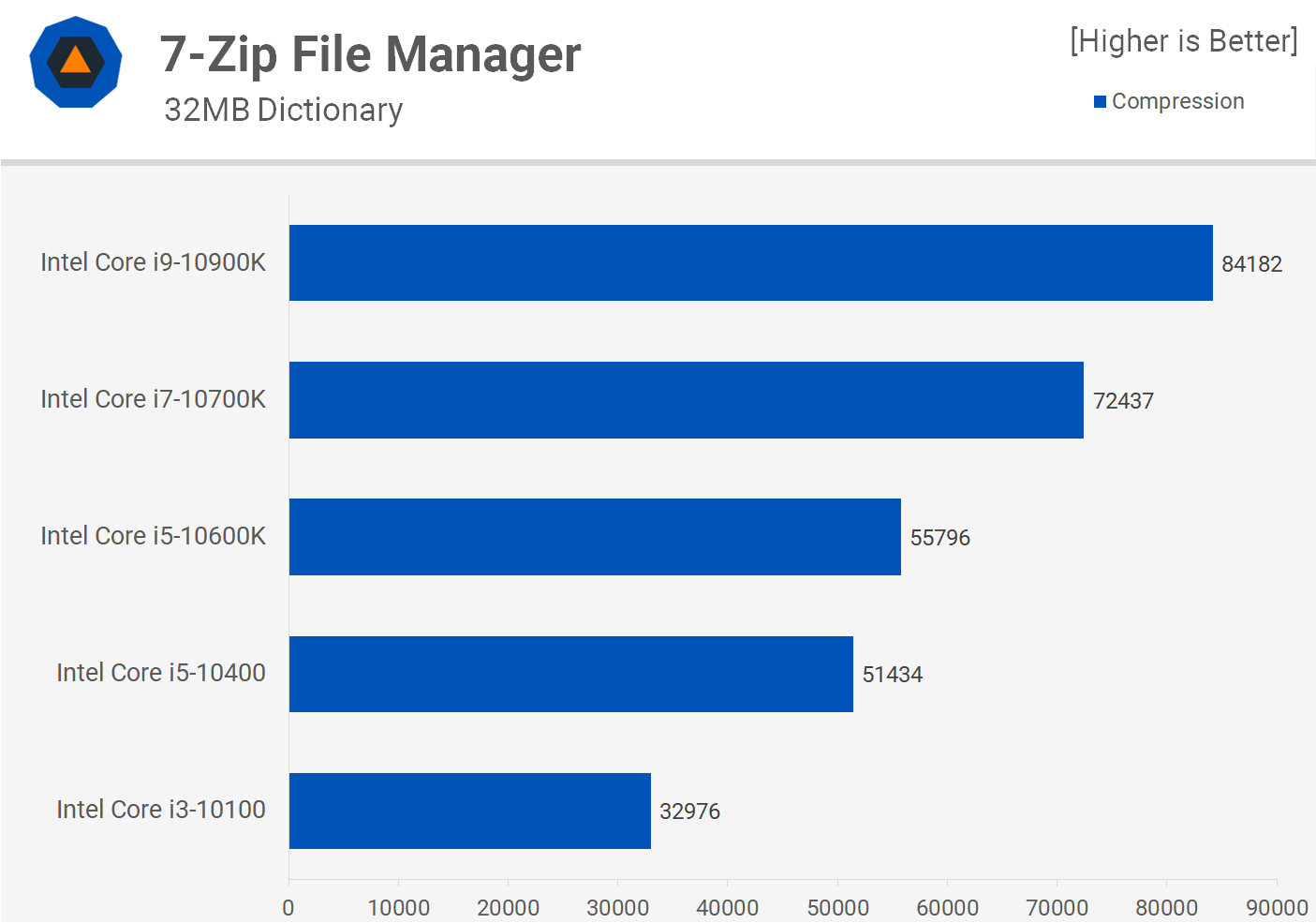
By far the nigh pregnant performance gains seen in the 7-Zip file manager compression exam are seen when moving from the iv-core Core i3-10100 to the 6-core 10400, which makes sense given this is the virtually significant increase in relative core count. The 10400 was 55% faster than the 10100, while the 10600K was a further 8% faster.
Then we come across a 30% boost from the 10600K to the 10700K which isn't insignificant, merely y'all could certainly debate that the 16% increase seen when going from the 10700K to the 10900K is, at the very least these results would make information technology hard to justify the xxx% increase in MSRP.
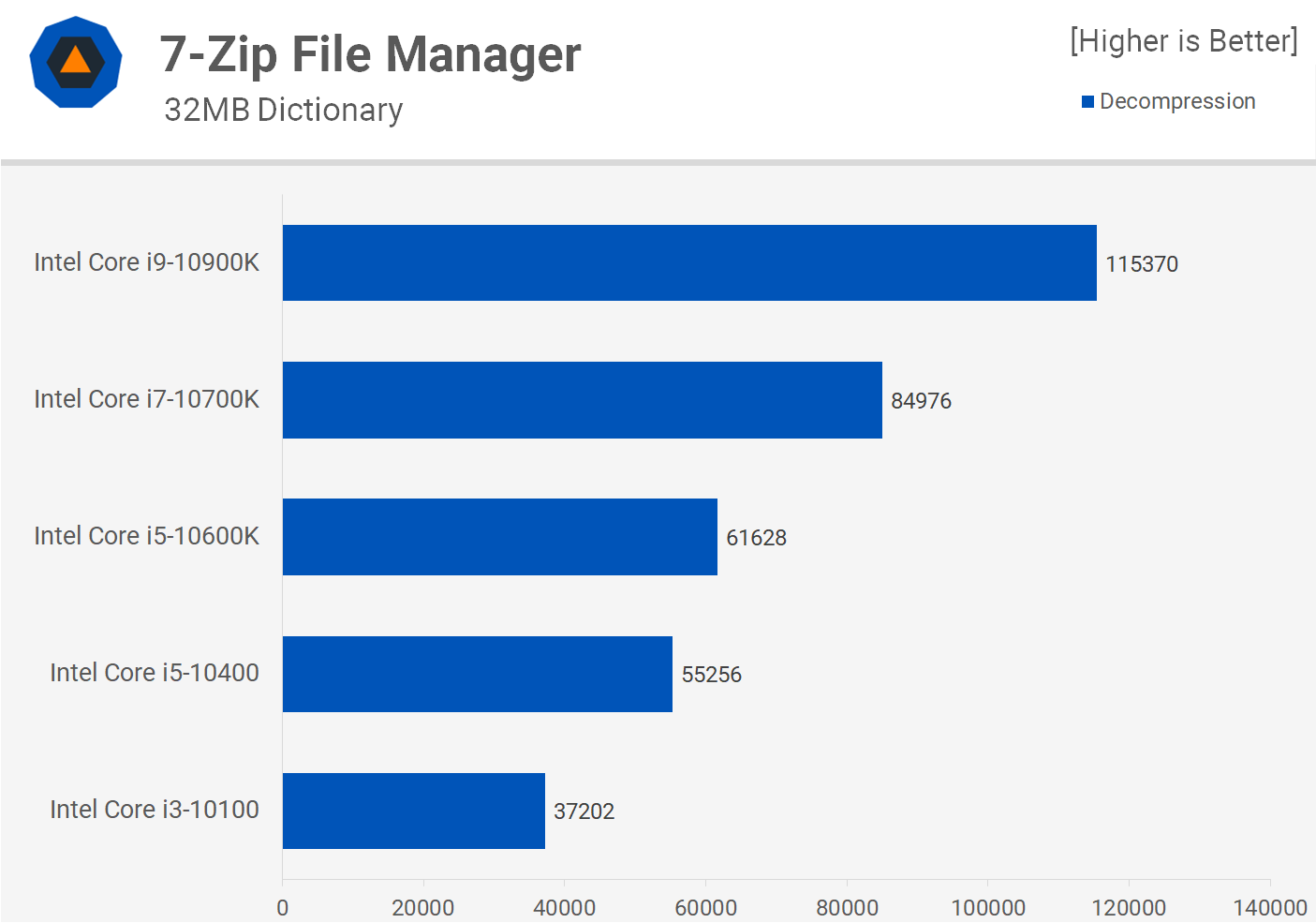
Decompression performance is much improved as here we're able to amend utilize Hyper-Threading and every bit a event the 10900K is now 36% faster than the 10700K, and that makes it much easier to justify the xxx% cost premium for the 10-core processor.
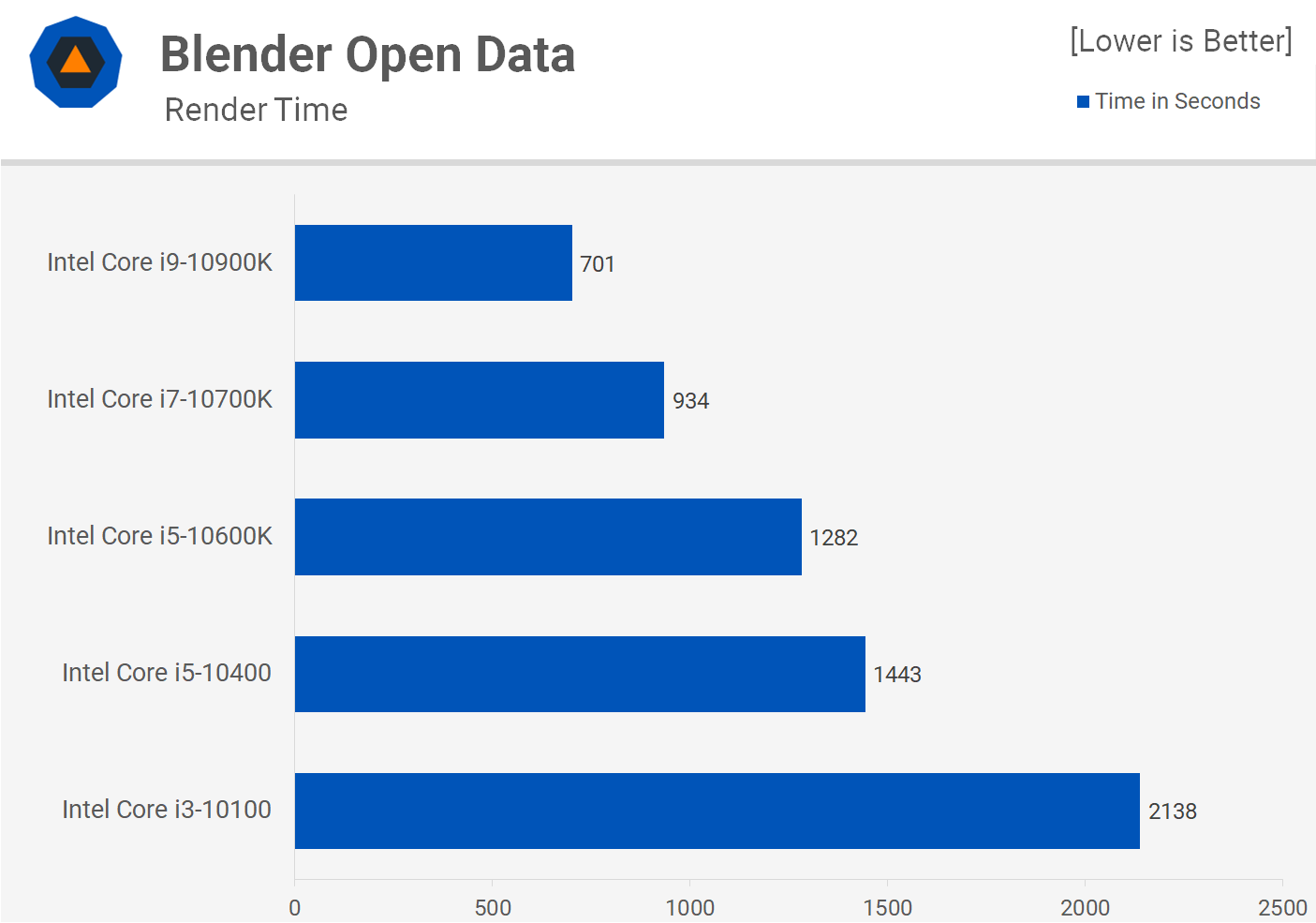
For whatever serious rendering-type workloads you'll want to avoid the Core i3 range when possible. Spending a flake more on the Core i5-10400, for example, will net you around 50% more performance. Granted it also costs ~50% more though that won't be the instance in one case you factor in the entire price of the machine. In reality, we're talking about $50 and that makes the 10400 a much better purchase if you plan to practice some rendering.
Over again we can run across that the deviation between the 10400 and 10600K is very small, at least out of the box. Then if you're going to buy the 10600K, yous want to overclock it, otherwise you might equally well salvage the $lxx-$80 and only get the locked 10400. Ideally, for this kind of workload you'll desire something like the 10700K or 10900K, if you're exclusively shopping Intel, of course. The 10700K offered a 37% performance boost over the 10600K while the 10900K was a further 33% faster.

Lawmaking compilation functioning is similar to what was constitute in the Blender test. We're looking at a 50% performance uplift when going from the 10100 to the 10400. From the 10600K to the 10700K you're once more looking at a 30% functioning increase and and then another 30% to the 10900K.
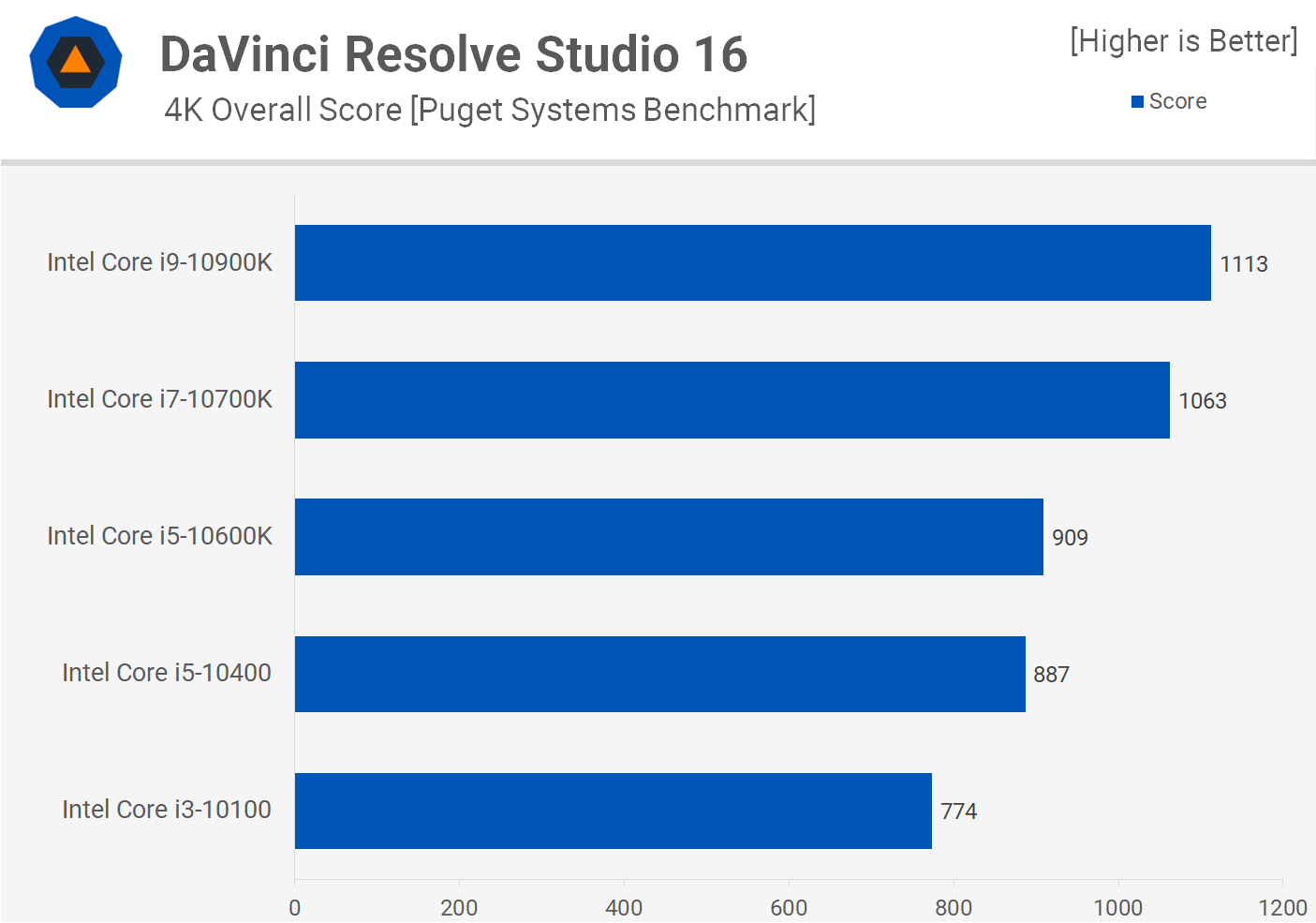
The margins are less predictable for video production piece of work. Here the Core i3-10100 fairs quite well, at least for the editing portion of the task. The 10400 was just xv% faster, while the 10600K was only a few percent faster than the locked i5 model. Interestingly, nosotros do see a reasonable boost in performance to the 10700K, but then only a very pocket-sized step up to the 10900K, suggesting that eight cores/xvi threads is the sweet spot for this awarding.
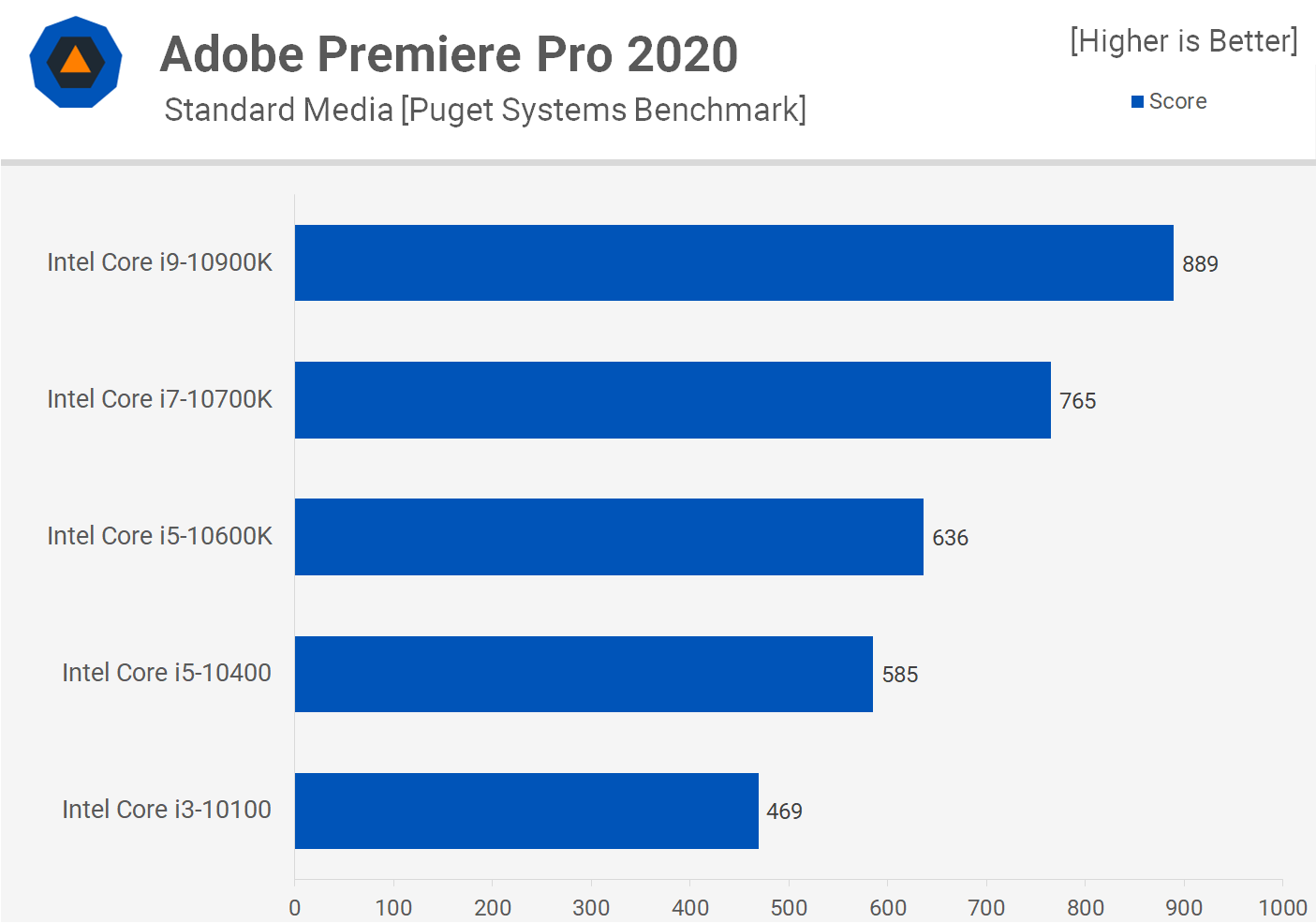
Scaling is more consequent in Adobe Premiere Pro, where nosotros see fairly consequent performance gains as the core count increases. For case, we see a 25% increase when going from the 10100 to the 10400, and a 16% increase from the 10700K to the 10900K.
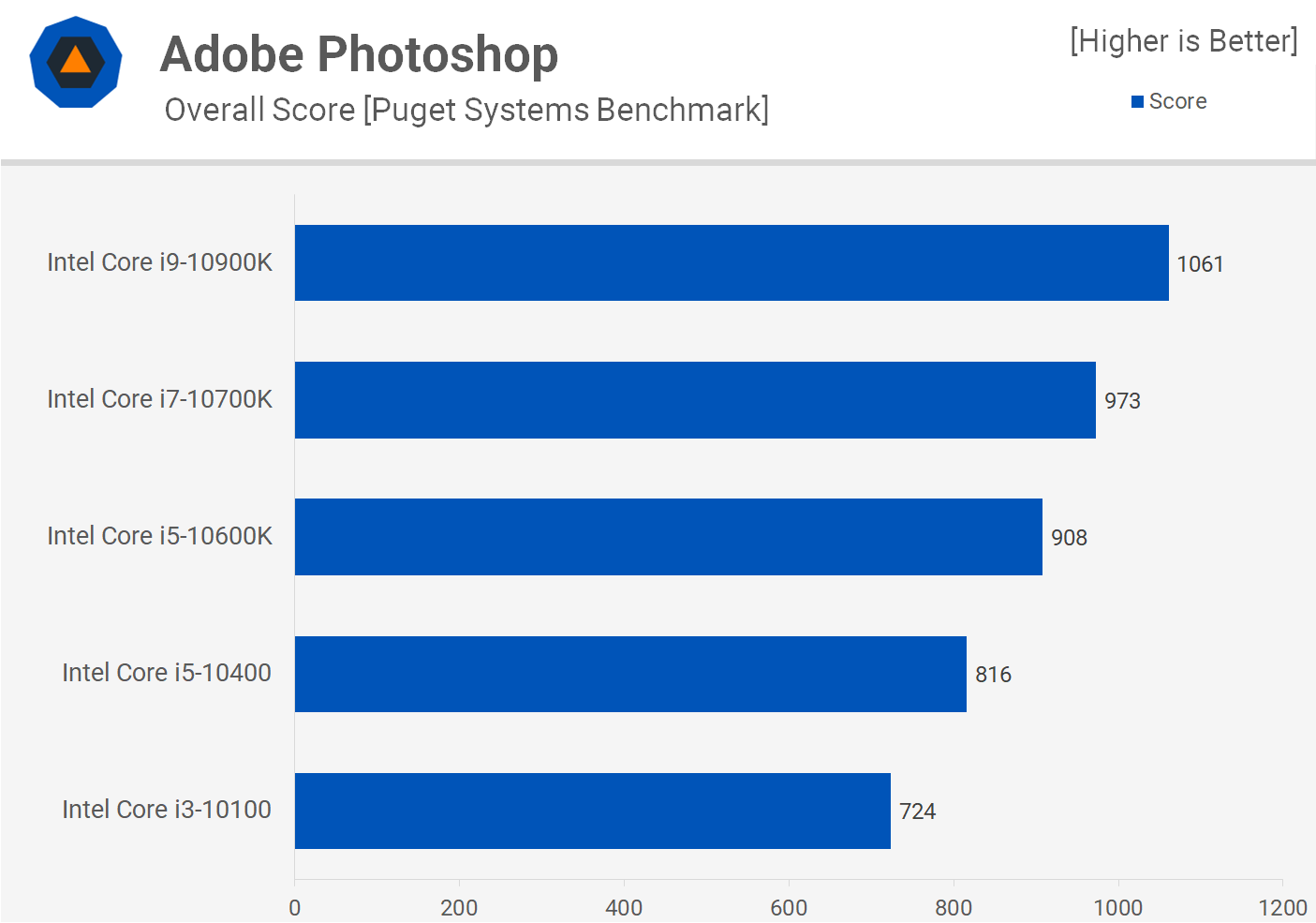
Adobe Photoshop mostly relies on single core performance, and for that same reason we didn't look to see a 47% performance increase from the Core i3-10100 to the Cadre i9-10900K. The i9 processor does enjoy a clock speed advantage as well equally a much larger L3 cache.
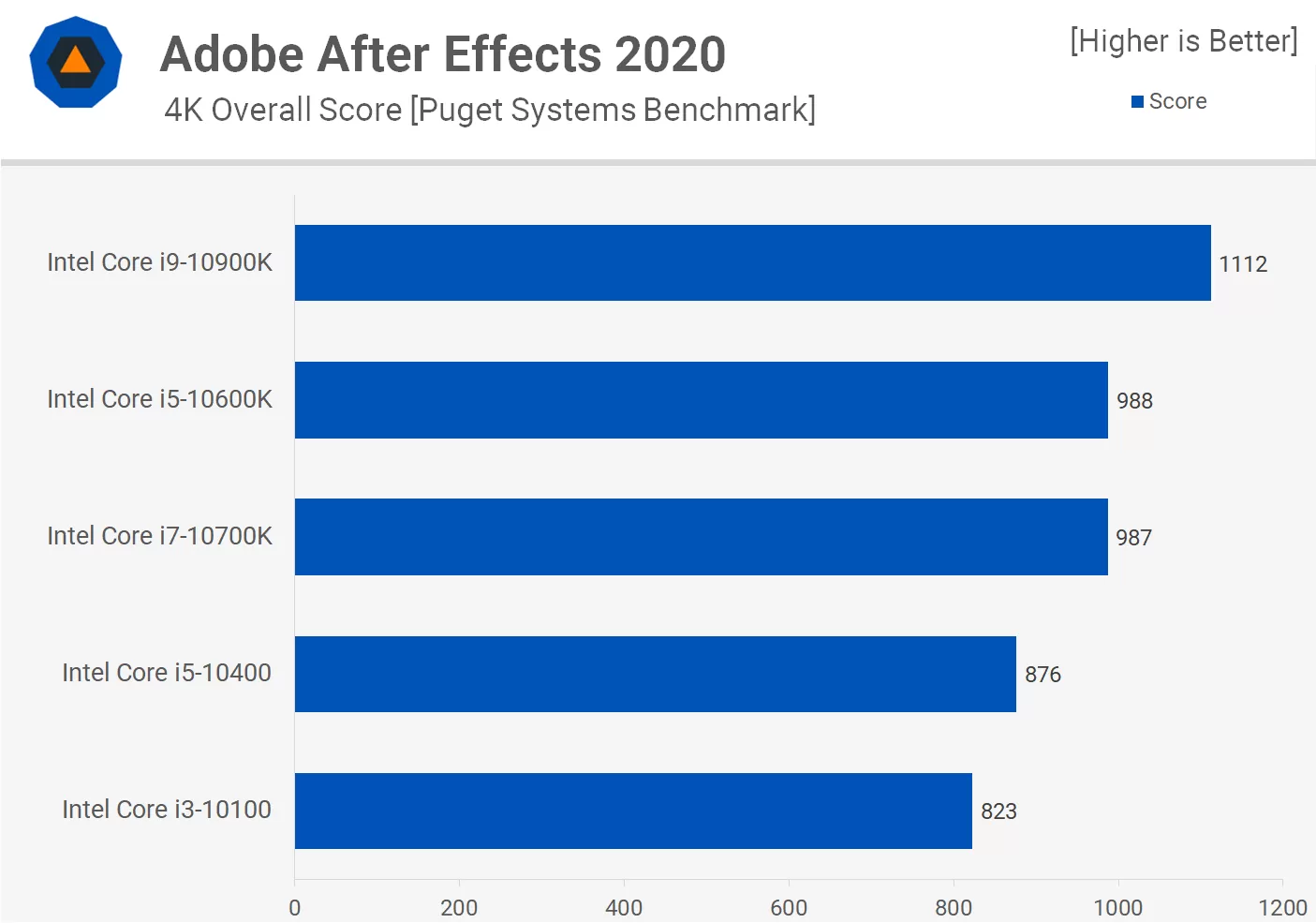
The margins seen in Afterward Effects are more than in line with our Photoshop expectations. The 10900K is 35% faster than the 10100, though the 10700K and 10600K are only 20% faster. It's interesting to see the 10600K and 10700K producing the same score, while the 10900K is around 13% faster, this is clearly a event of higher sustained frequencies.
Power Consumption
The Core i9-10900K is a beast, pushing total system consumption to 300 watts, a 70 watt increase from the 10700K. Meanwhile the 10700K pushed system consumption just xxx watts higher than the 10600K.

Gaming Functioning
Time for a look at gaming performance and outset upwards we have Battlefield V at 1080p with the ultra quality preset using an RTX 2080 Ti. The 10900K and 10700K are both GPU limited and as a issue they delivered the aforementioned average and i% low performance. The 10600K likewise managed to produce the same average frame rate but slipped abroad from the 1% low, abaft past an eight% margin.
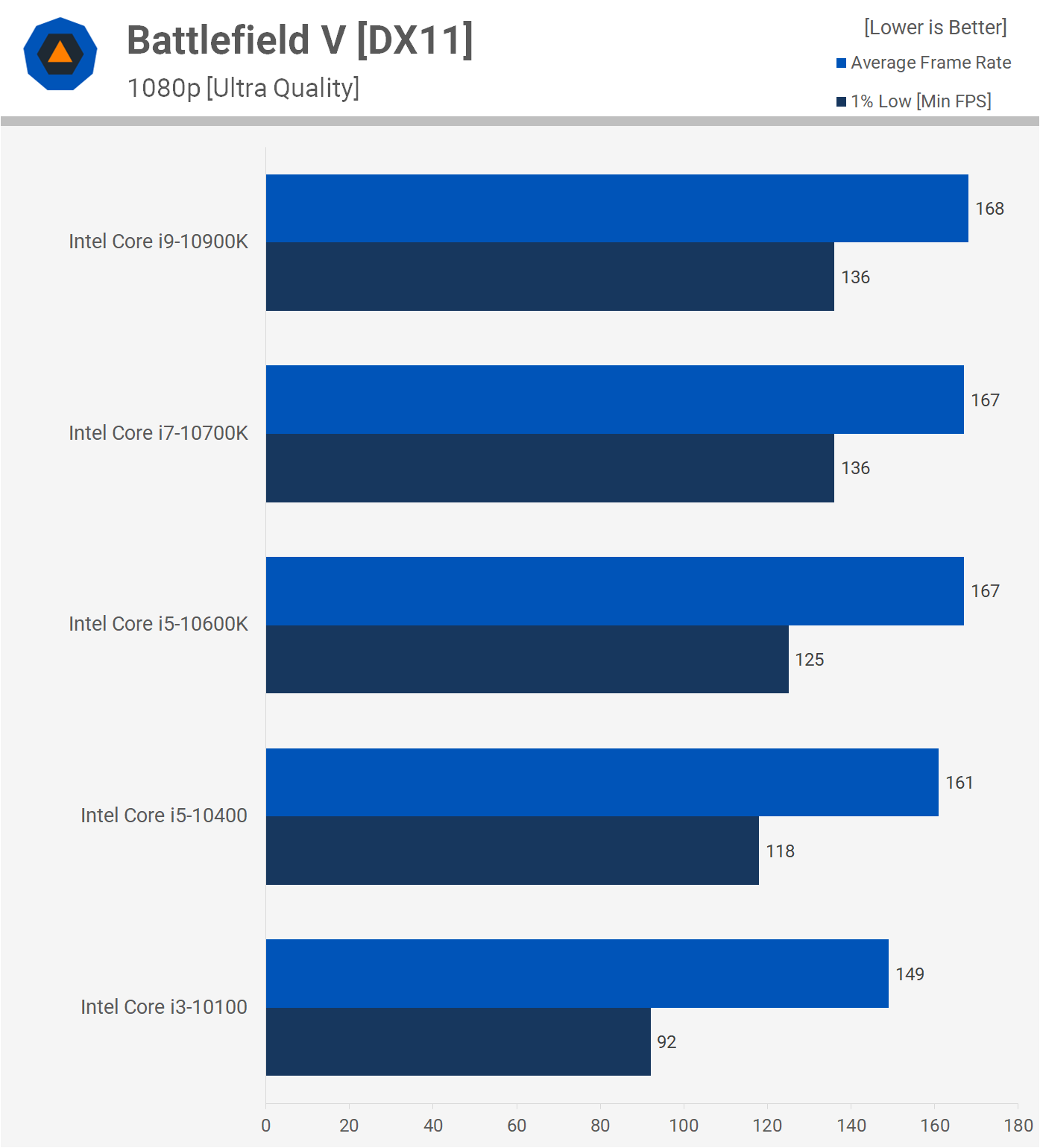
We meet a further 6% decline in performance with the 10400 so a rather large 22% drop off with the 10100. Notwithstanding, by increasing the resolution to 1440p for a more realistic test scenario, we discover very little difference in performance betwixt the 10400, 10600K, 10700K and 10900K. In fact, the boilerplate frame rates are near identical while the 10900K is at nearly ten% faster than the 10400 when comparing the 1% low operation.

All that said, the Core i3-10100 does still trail past a noticeable margin and while the operation is far from poor, y'all will at times be able to discover the difference betwixt the 10100 and 10400.
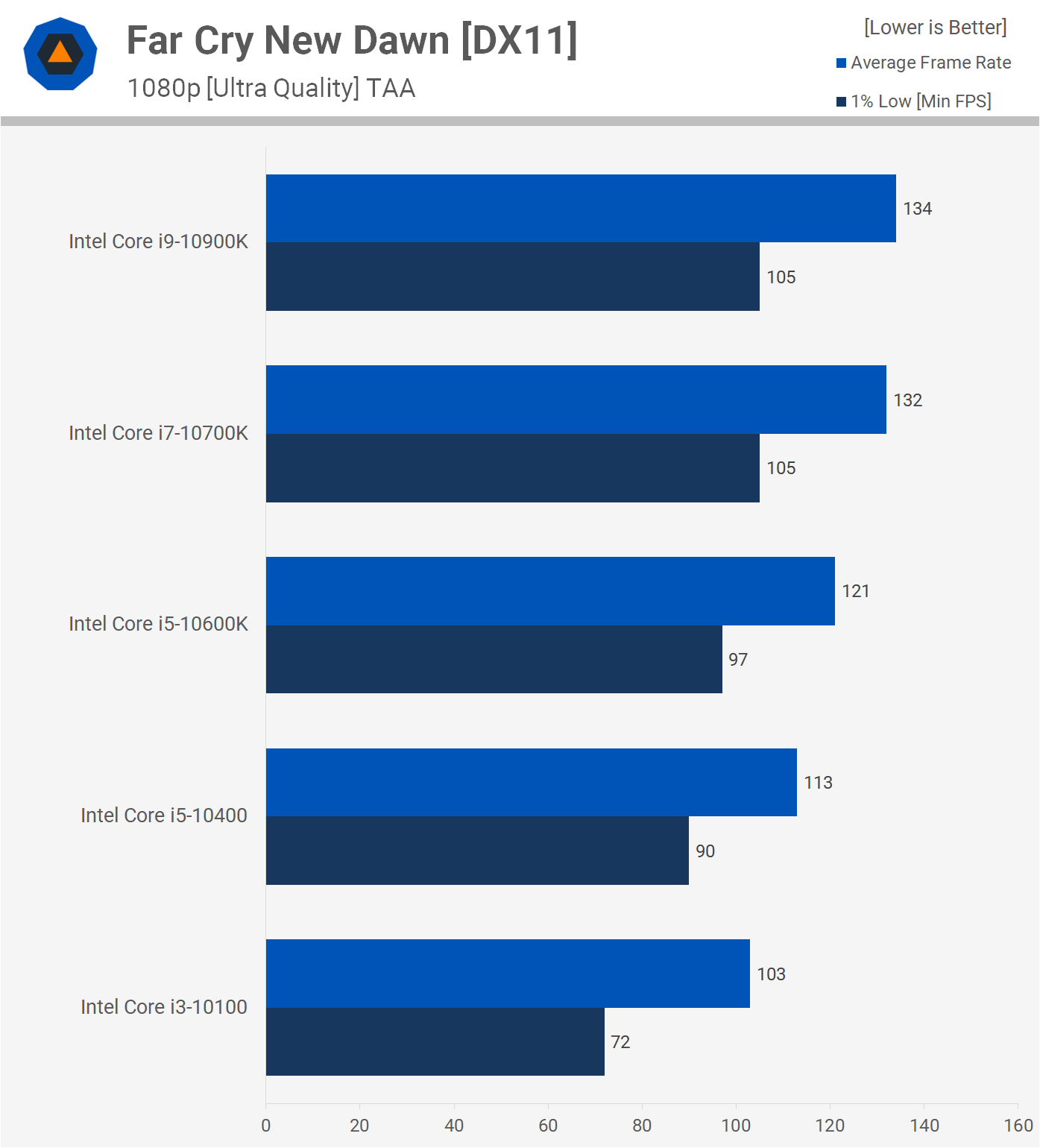

Far Cry New Dawn is very sensitive to clock frequency and cache functioning, and so we see a reasonably big performance uplift when moving from the 10100 to the 10400. The i5 processor was up to 25% faster. Of class, the jump from the 10400 to the 10600K is much smaller and the 8% increment is in line with the clock frequency difference.
Then nosotros're looking at a farther 9% heave when stepping upward to the 10700K and the i7 part basically matched the 10900K.
As we've seen many times in the past, increasing the resolution to 1440p tin really increase CPU load and as a event processors that were already struggling, similar the Core i3-10100, autumn further behind the competition. Hither the 10400 went from 25% faster at 1080p to 31% faster at 1440p.
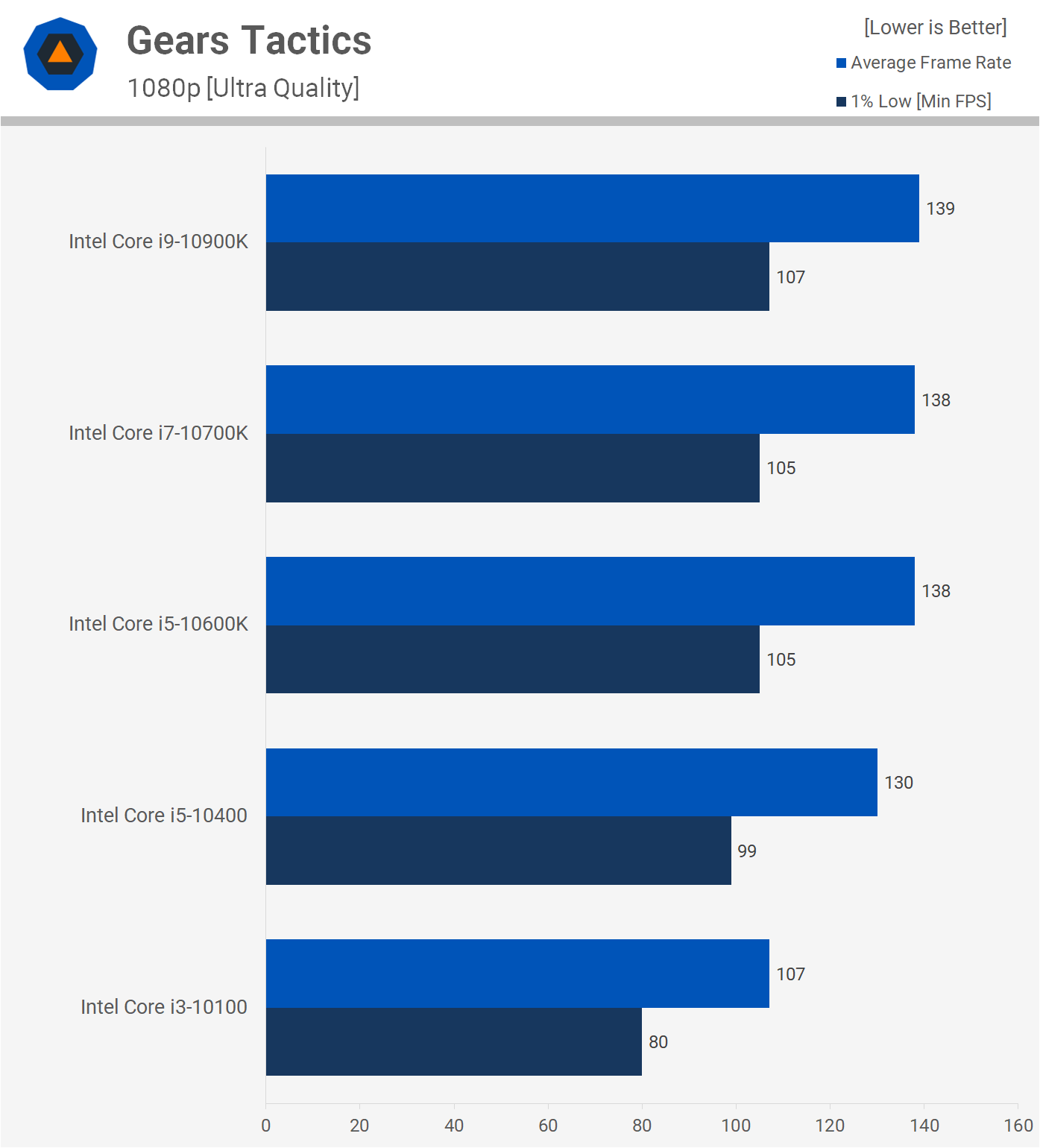
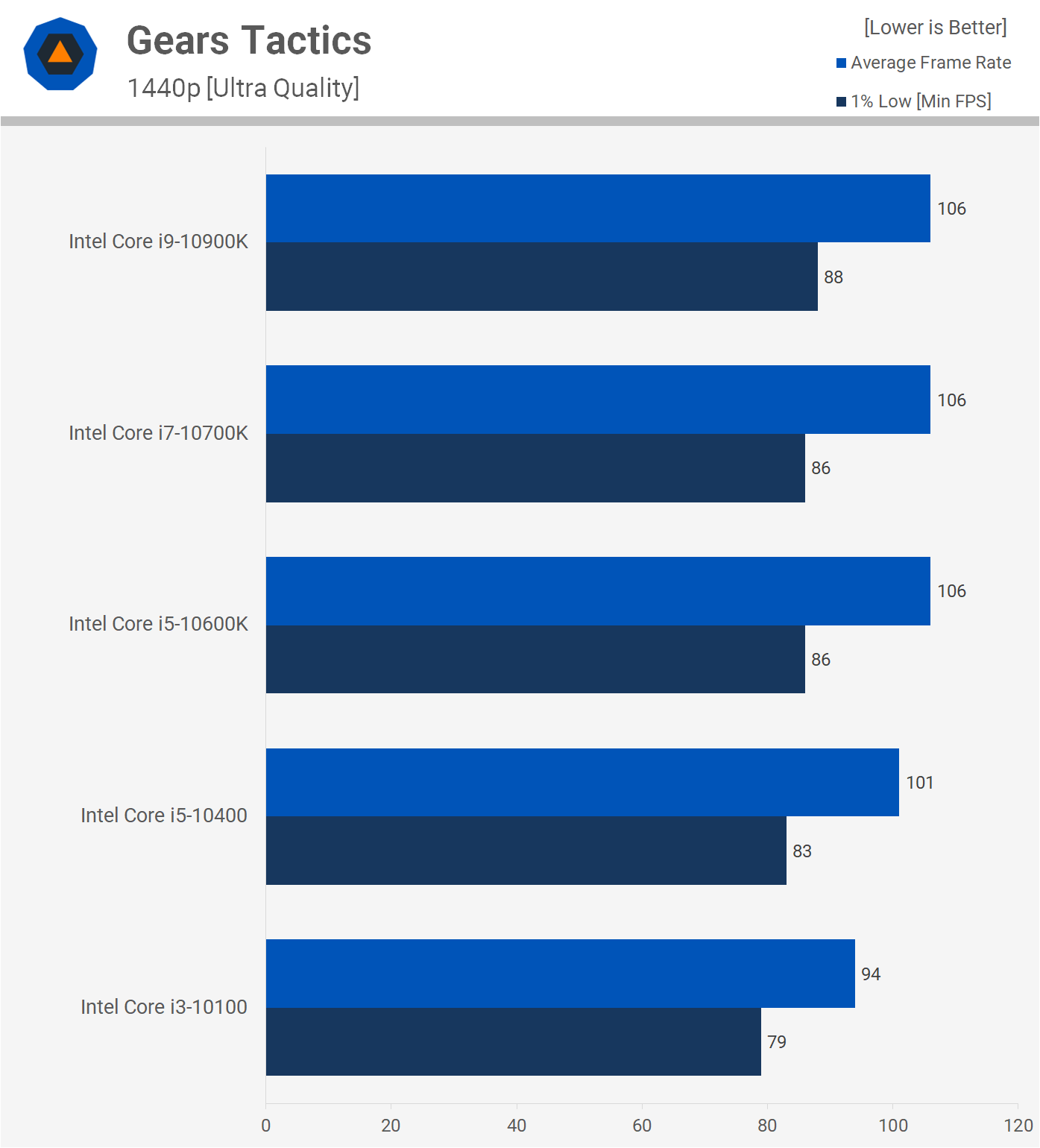
Side by side we have the Gears Tactics results and hither nosotros're looking at identical performance using either the 10600K, 10700K or 10900K. It'due south only the Core i3-10100 that struggles, trailing the 10400 past upward to a 20% margin.
Increasing the resolution to 1440p sees that margin reduced drastically, down to just seven% as the game becomes primarily GPU limited.
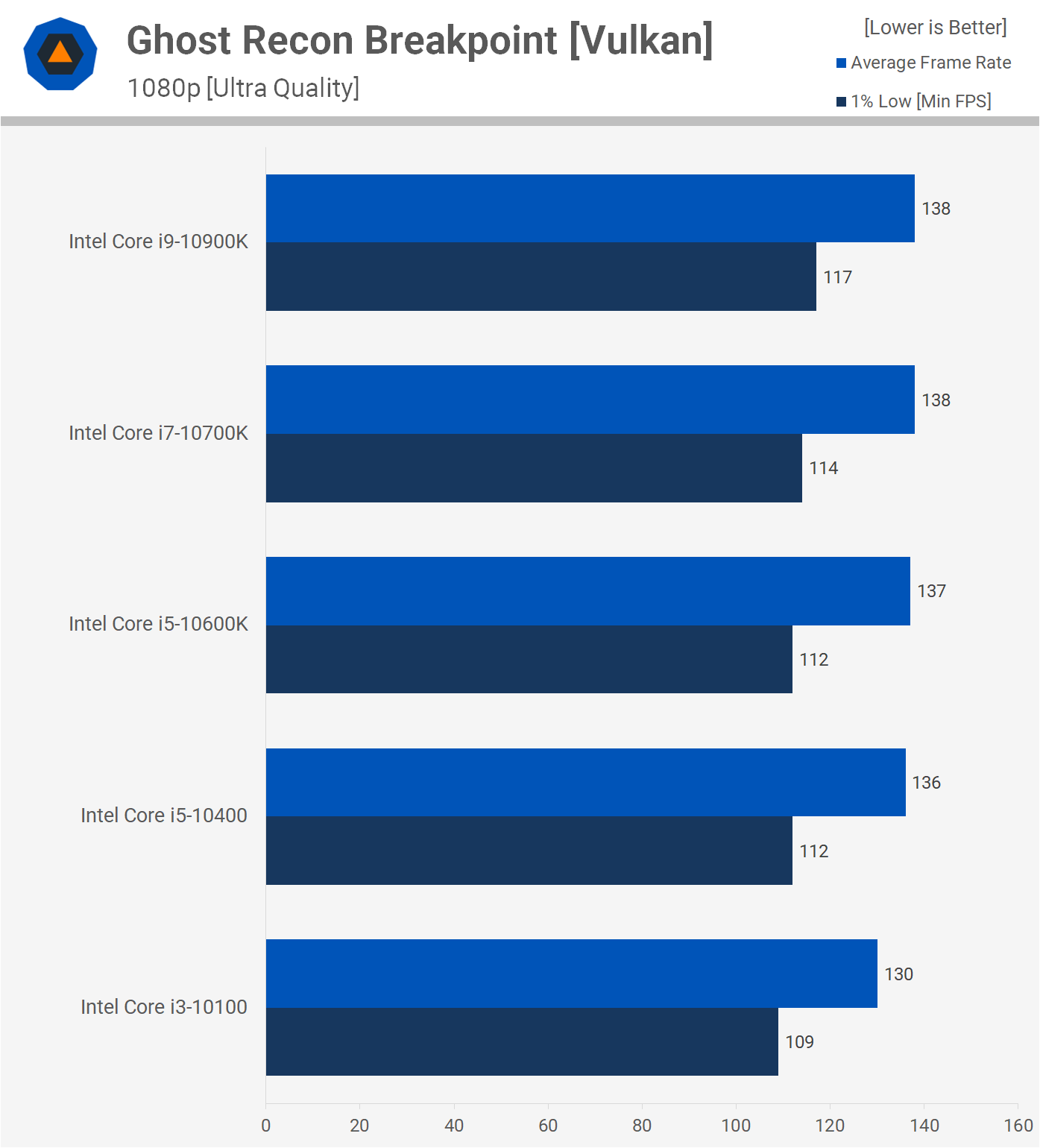
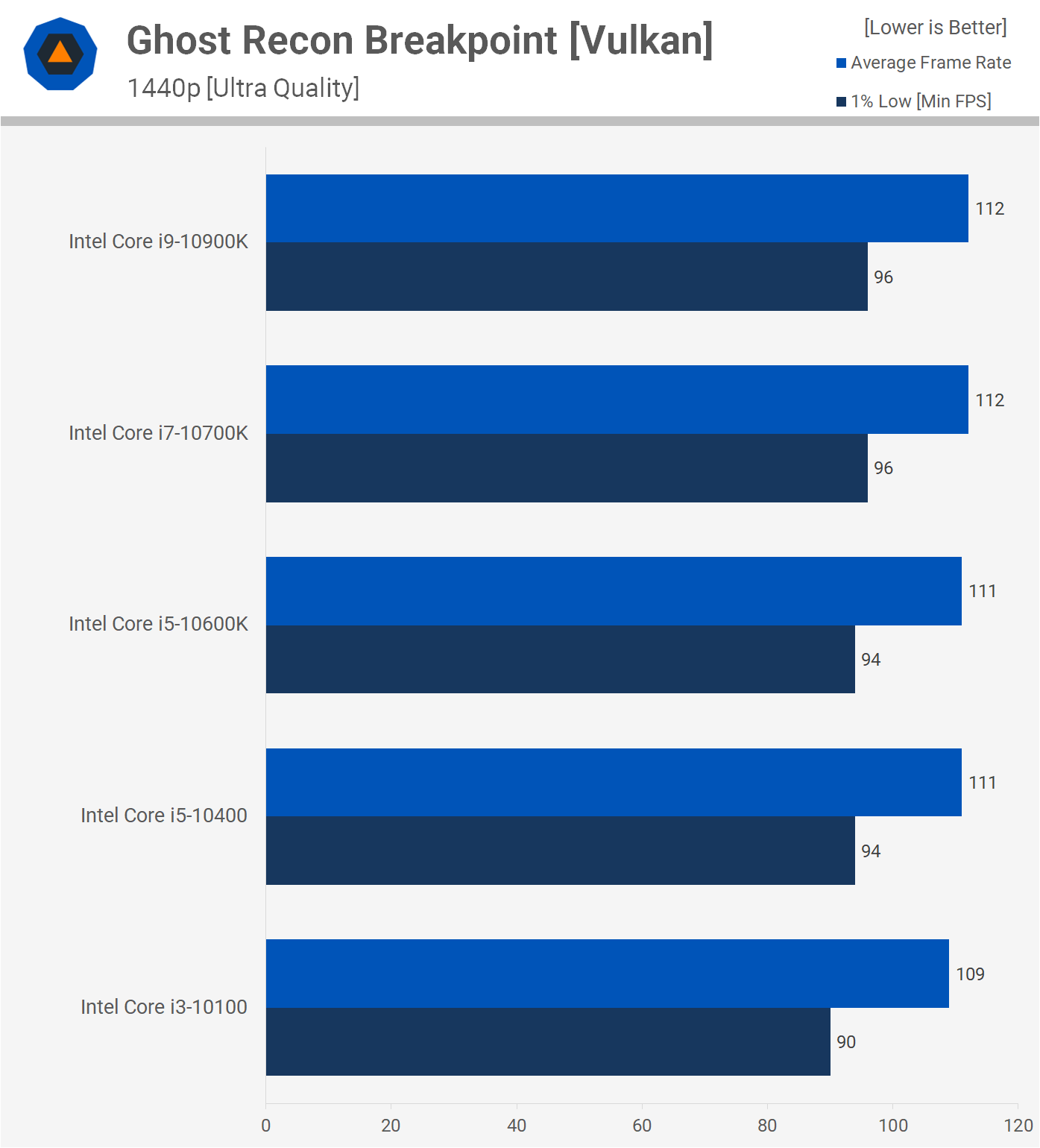
For titles like Ghost Recon Breakpoint that aren't particularly CPU sensitive, you lot won't notice a big difference between the Core i3-10100 and Core i9-10900K. This is particularly true when testing under more realistic weather such as 1440p. Hither the 10900K was up to 7% faster than the 10100 and on average rendered but 3 frames more per second. Then for games that don't require more than than 4 cores and aren't sensitive to CPU performance, these are the kind of margins you tin expect to find between these 10th-gen Core processors.
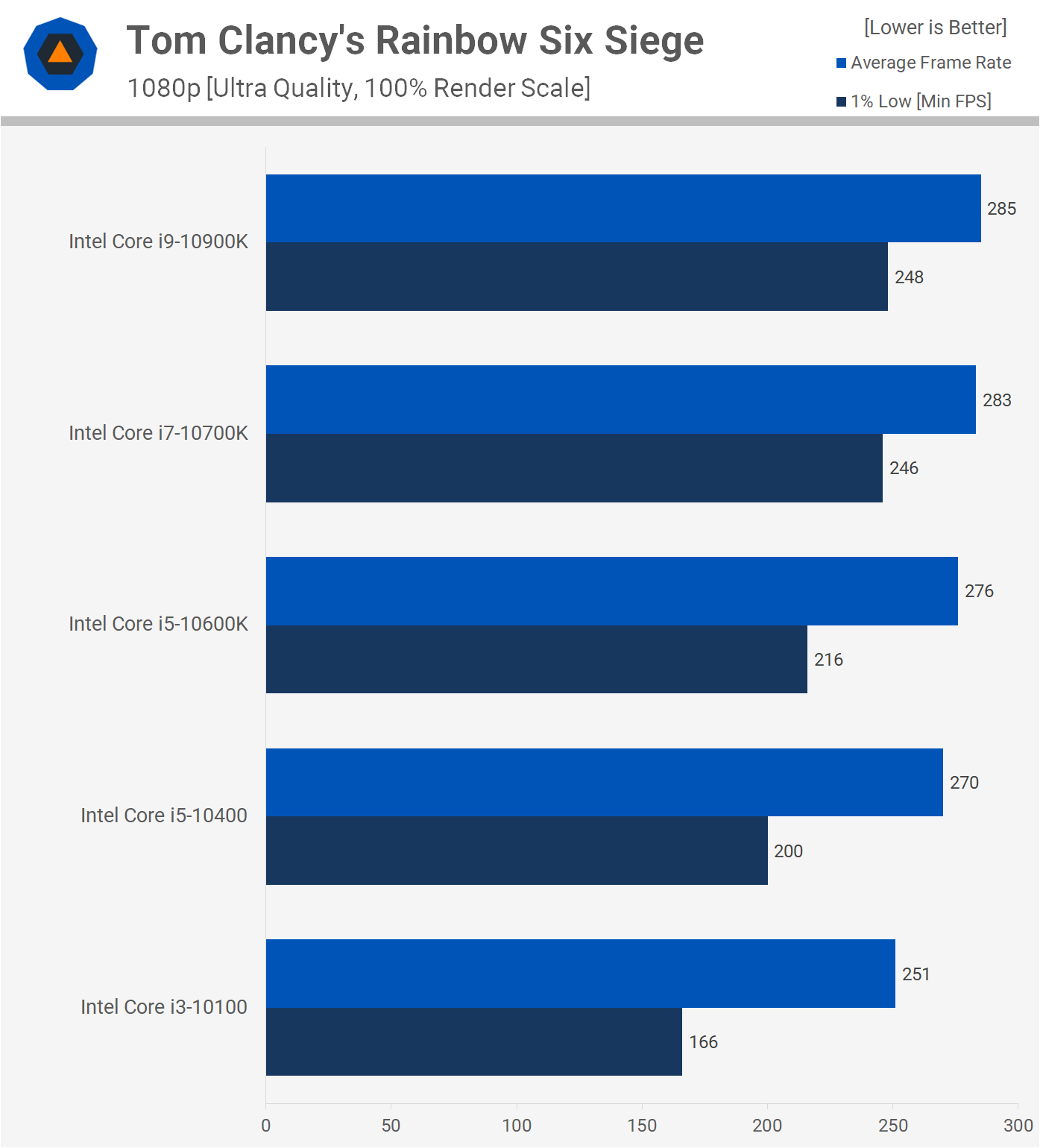
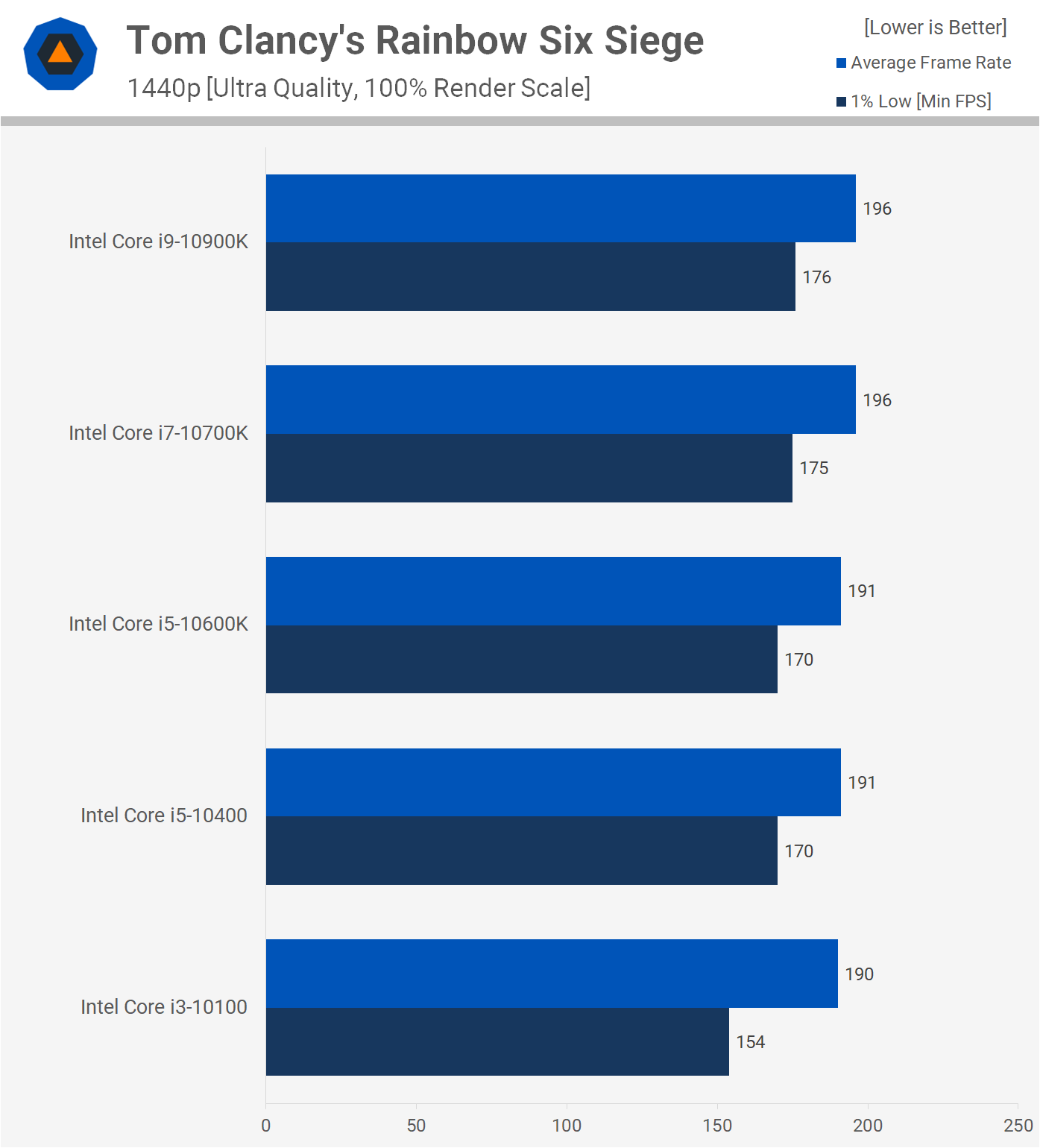
In Rainbow Half-dozen Siege the 10700K and 10900K are seen delivering near identical performance at 1080p. The 10600K is very close, though we exercise see a 12% reduction in 1% depression performance. Equally expected the 10600K and 10400 are very similar and then we see a further 17% reduction with the Core i3-10100.
Nonetheless, once again we find when increasing the resolution to 1440p, the added strain on the GPU is enough to almost completely eliminate the fps margins. Here the Core i5, i7 and i9 processors all deliver almost the same level of performance, while the i3-10100 is up to 13% slower when comparison the ane% depression results.
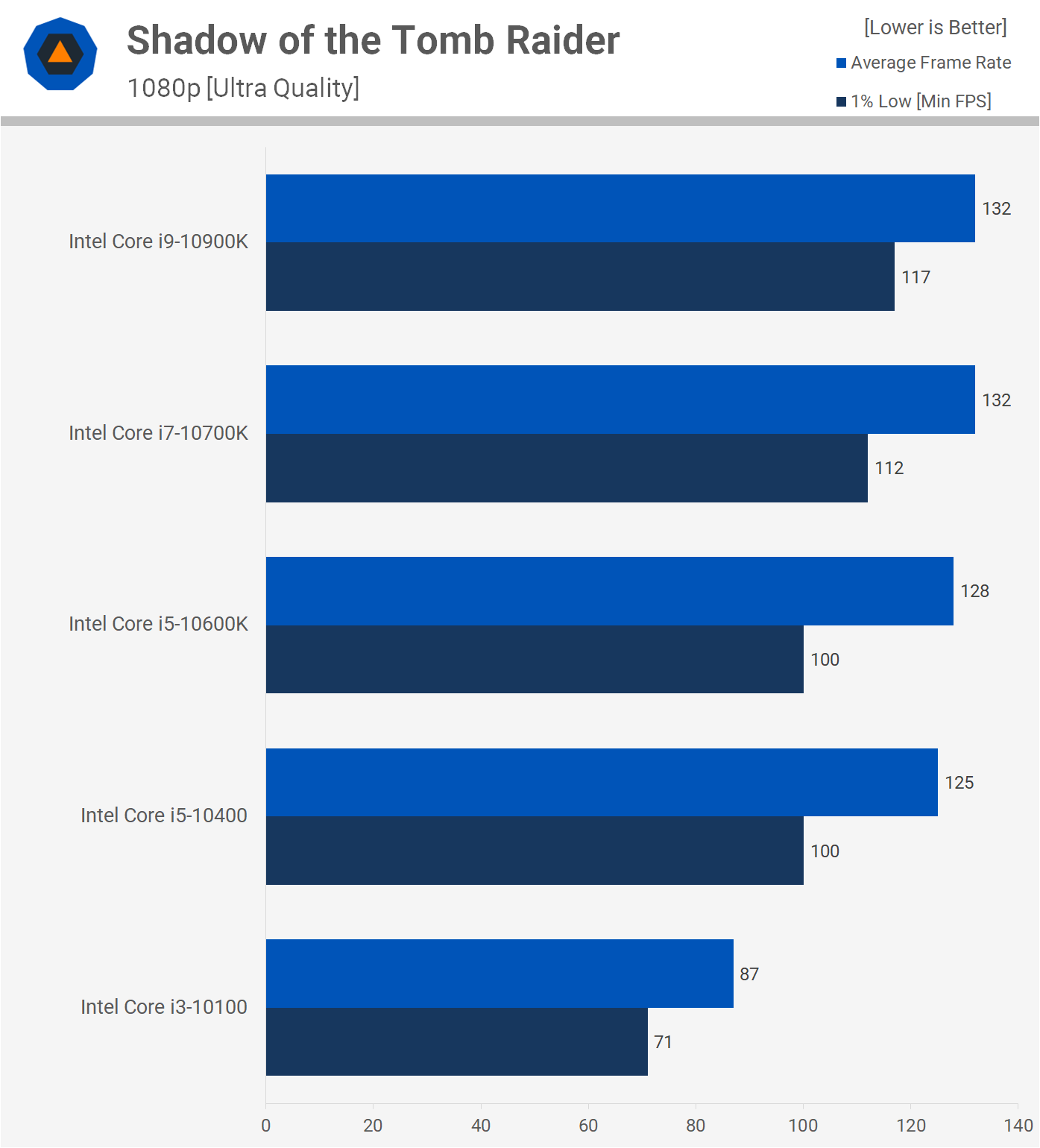
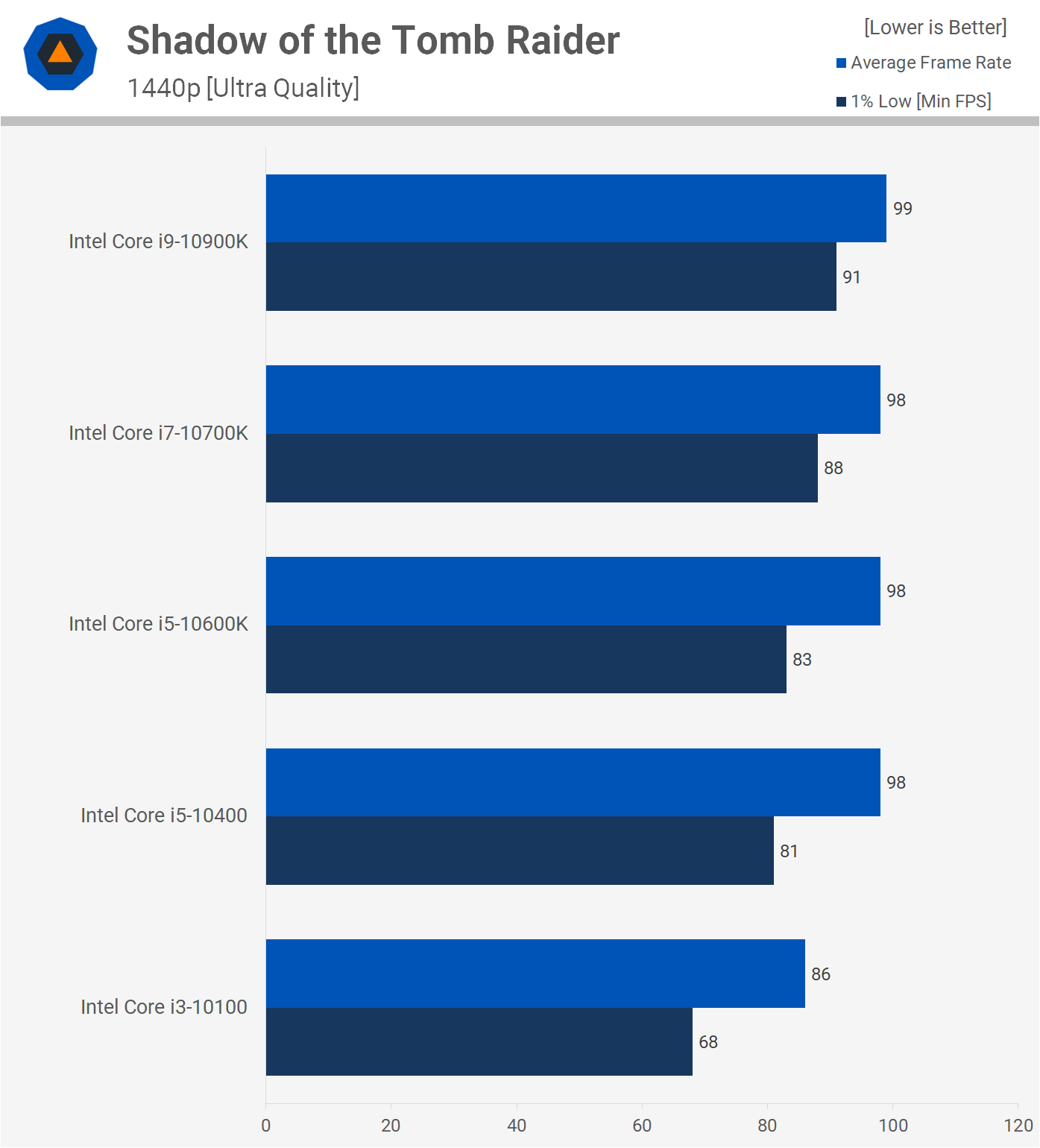
Certainly one of the most CPU enervating games that we currently test with is Shadow of the Tomb Raider and for this i you ideally desire a 6-cadre/12-thread processor. The Core i5 models aren't far behind the 8 and 10-cadre i7 and i9 parts whereas the quad-core Core i3-10100 is up to 39% slower.
Increasing the resolution to 1440p reduces the margins between the i5, i7 and i9 processors drastically. Now the 10900K is merely 12% faster than the Core i5-10400 when comparing the 1% low operation. Nonetheless, when compared to the Core i3-10100, it'southward upward to 33% faster and even the 10400 is 19% faster when comparing 1% depression performance. Then not an ideal game for those using quad-core processors and nosotros'll surely see more than of this moving forward.
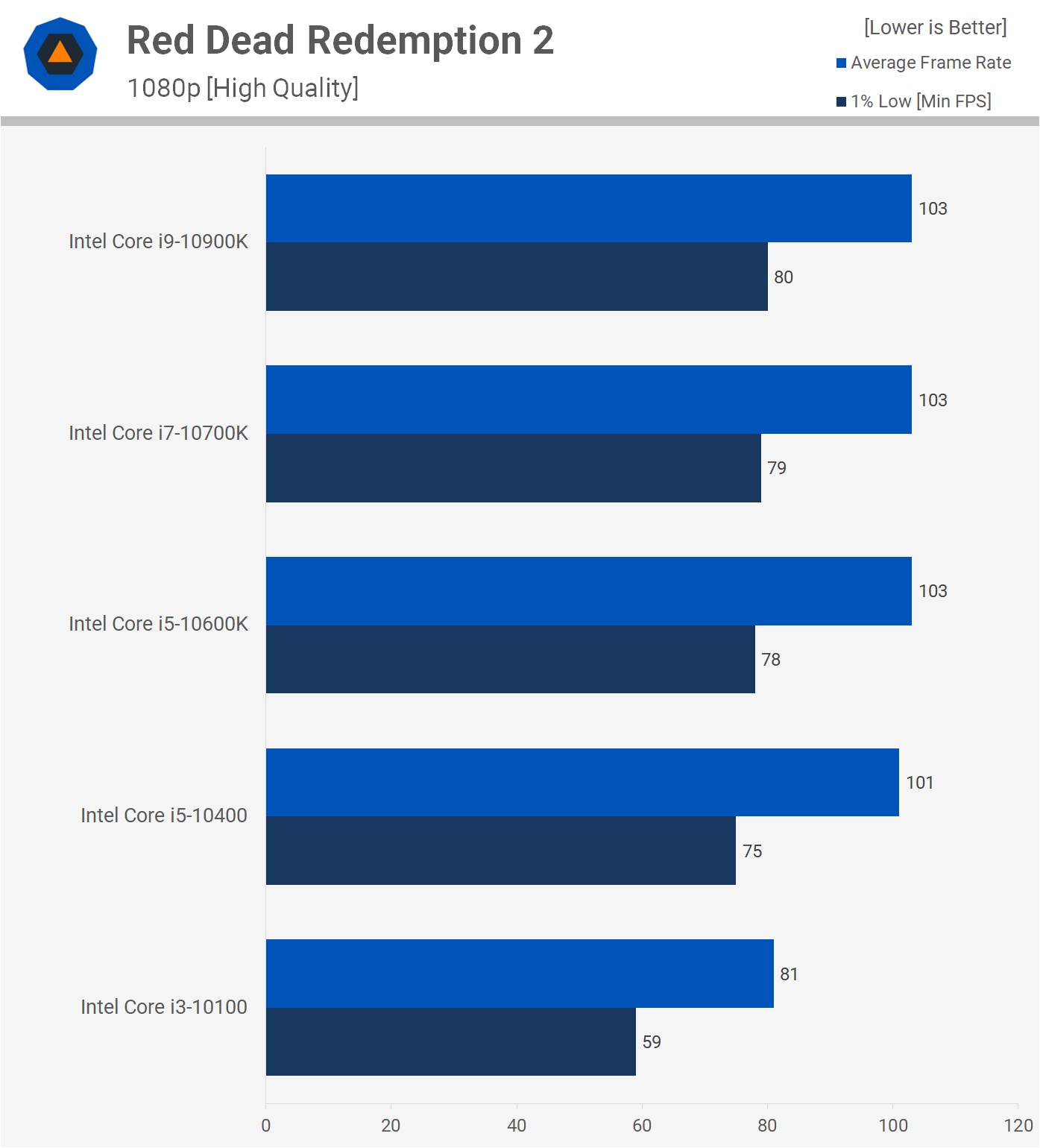
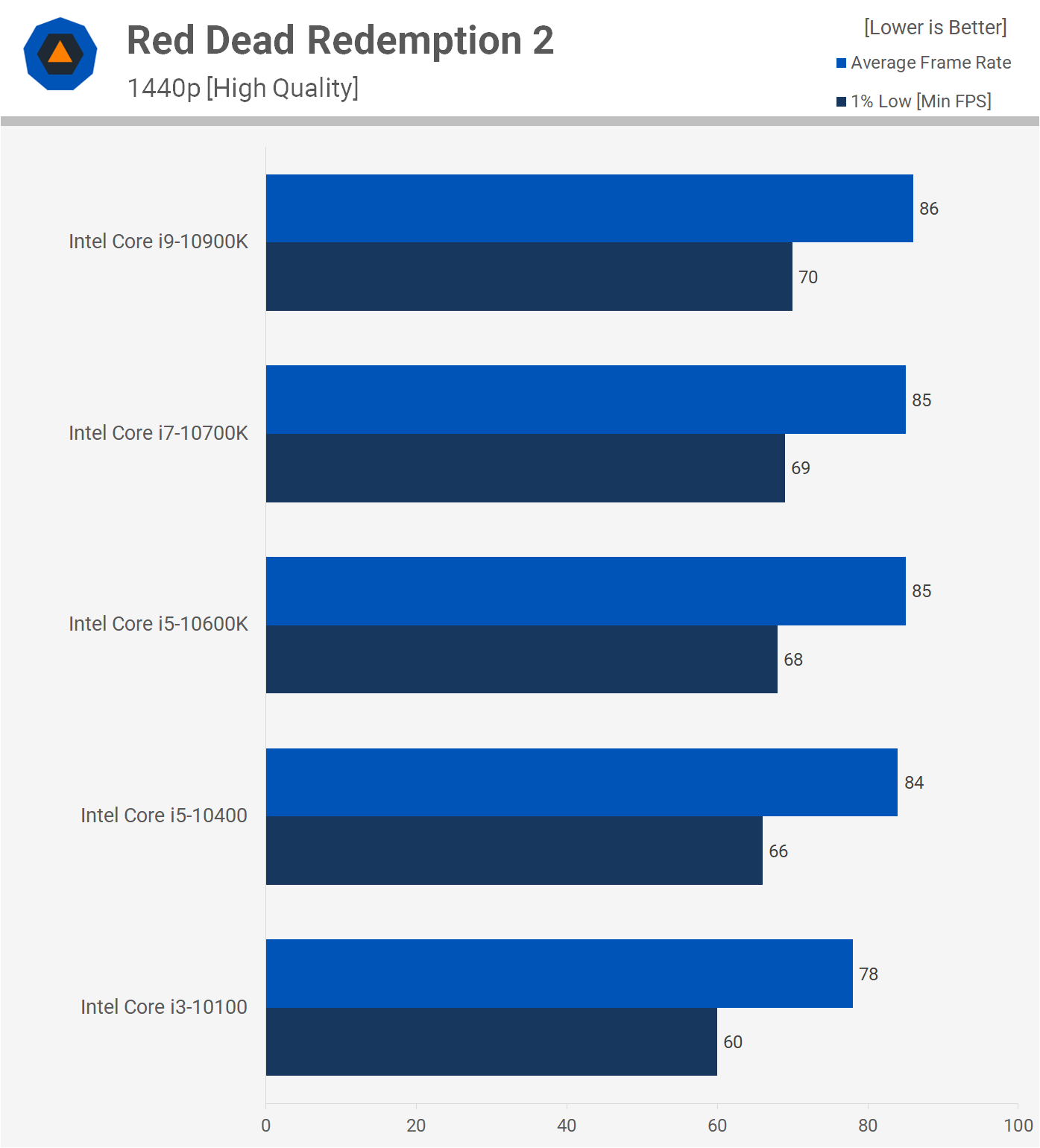
The last game in our benchmark round is Red Dead Redemption 2 and hither nosotros have some other title that doesn't play especially well with quad-core processors, even those with SMT support. Although nosotros see virtually identical performance between the various i5, i7 and i9 processors, the Core i3-10100 was up to 27% slower.
Increasing the resolution to 1440p did drastically reduce that margin and now the Core i3-10100 was but fourteen% slower than the 10900K and 9% slower than the 10400, when using an RTX 2080 Ti.
What Nosotros Learned
For budget gaming PCs, or general computing needs, the Core i3-10100 works well enough. For non a great bargain more though, we practice feel the Core i5-10400 is a much amend investment. The Core i3-10300 and 10320 might fare a little ameliorate thanks to the larger L3 cache chapters and the slightly college clock frequencies, only considering both are more expensive, information technology makes even more sense to but get the Core i5 bit.
If you tin find it and plan on using a discrete graphics card, the Cadre i5-10400F is the manner to go. This part might fifty-fifty exist better value than the Ryzen 5 3600, which is saying something. At around $160, it'south a mighty tempting alternative then keep that in listen.
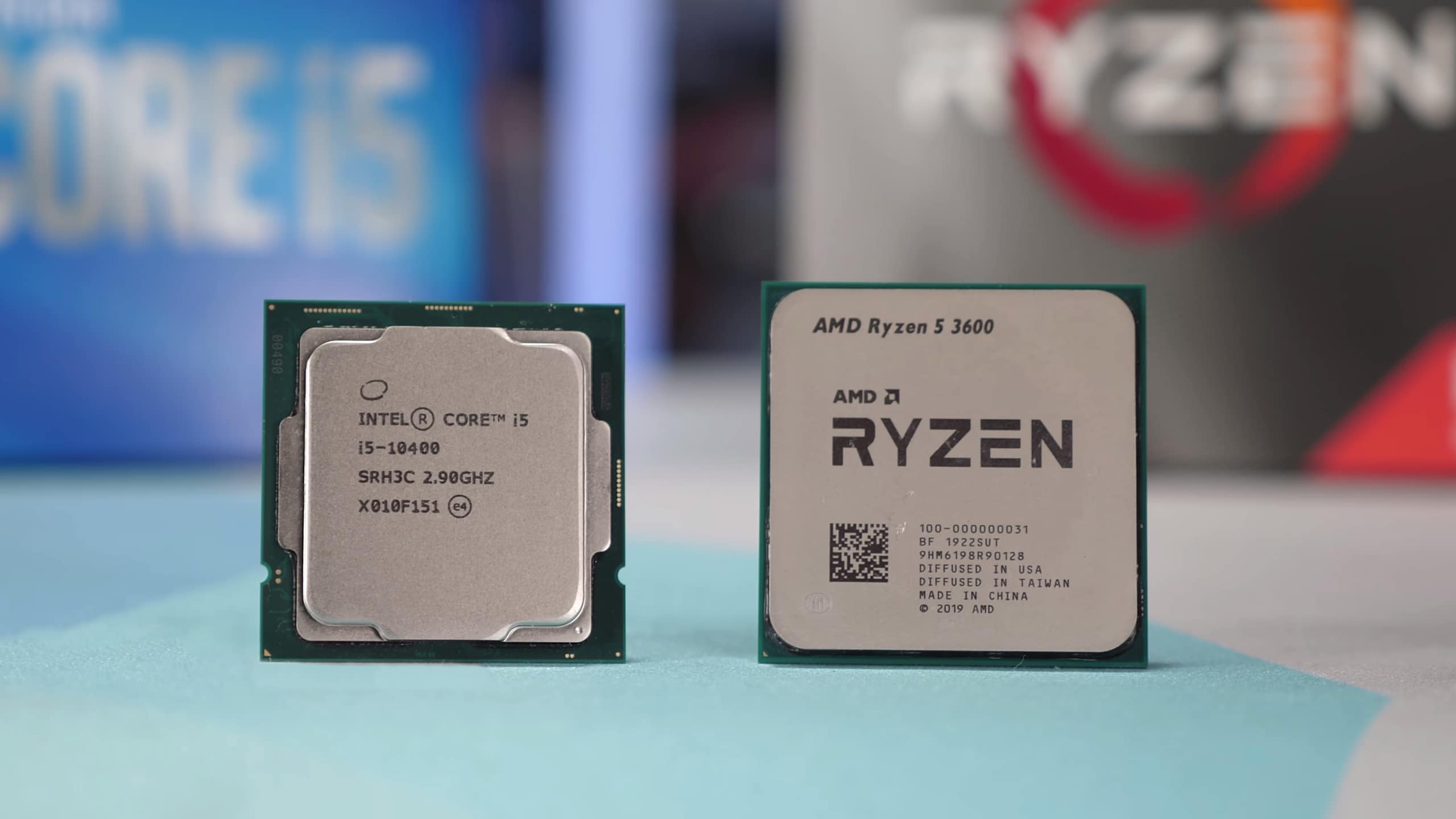
Beyond that, the Core i5-10500 and 10600 certainly won't be worth the toll premium, at least not at the current request prices. Even the 10600K is a stretch at a little over $300, though if y'all program to overclock then it can brand sense for high refresh rate gaming.
The Cadre i7-10700K is as well a lilliputian overpriced right now and at $410 you really have to be able to put those 8 cores to work. The Cadre i9-10900K is a beast of a processor, just at $530 it'south ~$100 more AMD's 12-core/24-thread Ryzen ix 3900X, and that's a large problem for Intel. Though possibly an fifty-fifty bigger problem is its lack of availability.
Shopping Shortcuts:
- Intel Cadre i9-10900K on Amazon
- AMD Ryzen 9 3900X on Amazon
- Intel Cadre i7-10700K on Amazon
- Intel Core i5-10600K on Amazon
- Intel Core i5-10400 on Amazon
- AMD Ryzen 5 3600X on Amazon
- Intel Cadre i3-10100 on Amazon
Source: https://www.techspot.com/review/2061-intel-core-versus/
Posted by: jonesobbect1991.blogspot.com


0 Response to "Intel Core i3 vs. Core i5 vs. Core i7 vs. Core i9"
Post a Comment